Juniper Systems 22553 802.11b/g Module User Manual Host
Juniper Systems, Inc. 802.11b/g Module Host
Contents
- 1. Host User Manual
- 2. Owners Manual
Host User Manual
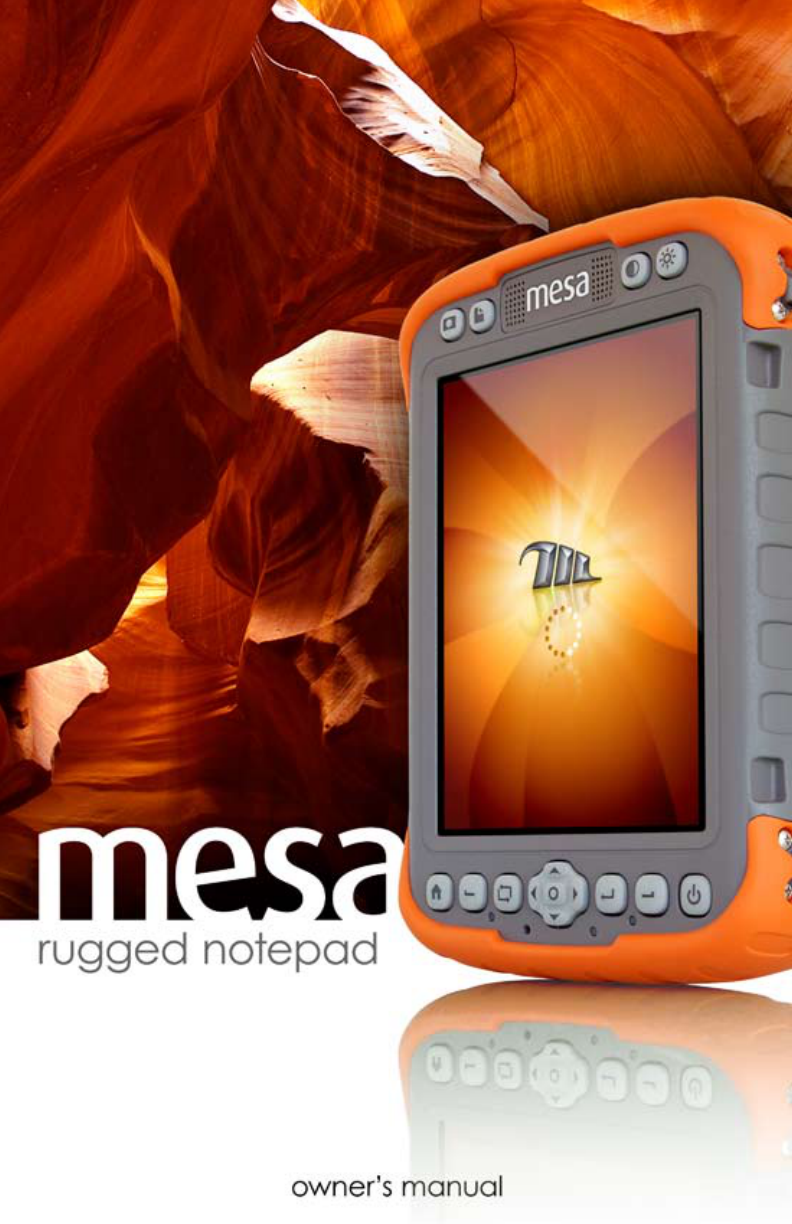

ActiveSync, Excel, Hotmail, Internet Explorer, Microso, MSN,
Outlook, PowerPoint, Visual Studio, Windows, Windows
Media, Windows Mobile, Windows Mobile Device Center,
Windows Vista, and the Windows logo are trademarks or
registered trademarks of Microso Corporation in the United
States and/or other countries.
The Bluetooth® word mark is owned by the Bluetooth SIG, Inc.
and any use of such marks by Juniper Systems, Inc. is under
license.
Acrobat and Reader are registered trademarks of Adobe Systems
Incorporated in the United States and/or other countries.
The names of actual companies and products mentioned herein
may be the trademarks of their respective owners.
© Copyright 09-2010 Juniper Systems, Inc. All rights reserved.
Juniper Systems and the Juniper Systems logo are registered
trademarks of Juniper Systems, Inc. Mesa Rugged Notepad
and Mesa Mobile Dock are recognized trademark of Juniper
Systems, Inc.
P/N 22813.X2
WARNING! This symbol indicates that failure to follow
directions could result in serious injury.
CAUTION: This symbol indicates that failure to follow
directions could result in damage to equipment or loss of
information.
!!
!!

Contents
1 Getting Started
The Anatomy of the Mesa 6
Performing Initial Tasks 8
2 Hardware Components
Navigating Around Your Mesa 16
Home Screen and Windows Start Menu 17
Display and Touchscreen 18
Keypad Features 20
Power Management 24
LED Activity Indicators 26
SD Cards 26
Connector Module 27
Audio Features 28
3 Programs and Settings
The Home Screen 30
Suspend, Reset, Power O, and Restore the Mesa 35
Communicating with a Desktop Computer 37
Getting Started Screen and Online Help 38
Information for Software Developers 40
4 Bluetooth® Wireless Communication
Creating a Partnership 42
Microsoft Bluetooth Control Panel 44
Serial Device (COM) Control Panel 46
5 Wi-Fi Wireless Communication
Connecting to a Wi-Fi Network 50
Contents iii

6 Geo Models
GPS 54
Camera 59
7 3G Data Modem
Set up a Data Account with a Wireless Provider 64
Install the SIM Card 64
Set up the Cell Modem 66
Wireless Safety 67
Maintenance of Your Modem 68
8 Storage, Maintenance and Recycling
Storing the Mesa and Battery Pack(s) 70
Protecting the Touchscreen 71
Cleaning the Mesa 71
Recycling the Mesa and Batteries 72
9 Warranty and Repair Information
Limited Product Warranty 76
Extended Warranties 78
Repairing the Mesa 79
A Specications
Mesa Rugged Notepad Specications 82
B Warnings and Regulatory Information
Product Warnings 90
Mesa Certications and Standards 91
C Charging and Docking Accessories
Mesa Mobile Dock 96
Mesa Travel Charger 103
Index
iv Mesa Rugged Notepad Owner’s Manual
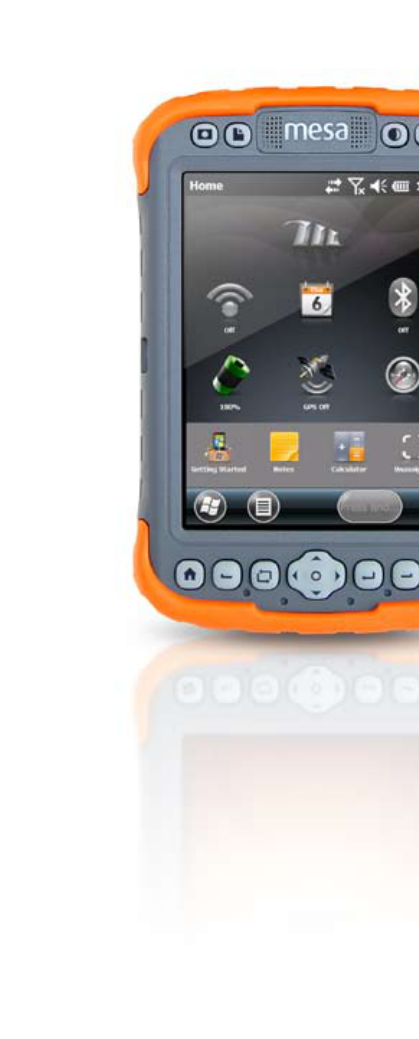
1
Getting
Started
6 The Anatomy of the Mesa
8 Performing Initial Tasks
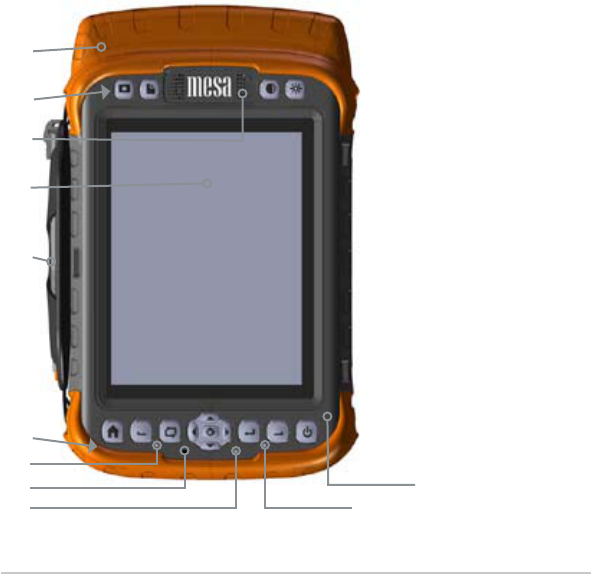
6 Mesa Rugged Notepad Owner’s Manual
Mesa Rugged Notepad
The Mesa Rugged Notepad™ from Juniper Systems is designed
for collecting data in rugged environments. Features include:
Windows Mobile® 6.5.
Large daylight readable VGA display
Large on-screen buons for touch-friendly operation
Rugged environmentally sealed design
Bluetooth® wireless technology
Wi-Fi 802.11b/g, U.S. and international
Dual baery option for long operating life
3.2 MP camera and internal GPS (Geo models)
Cellular modem option for Geo models
The Anatomy of the Mesa
Mesa Front View: Buttons, Touchscreen, Speaker, LEDs
1
2
7
4
6
3
5
8
9 10
11
1 Extended antenna
bumper (Geo models)
2 Function buttons
3 Speaker
4 Display with
touchscreen
5 Handstrap and
stylus
6 Navigation buttons
7 Green suspend/
resume indicator LED
8 Microphone
9 Blue LED
10 Red charging LED
11 Magnesium case front
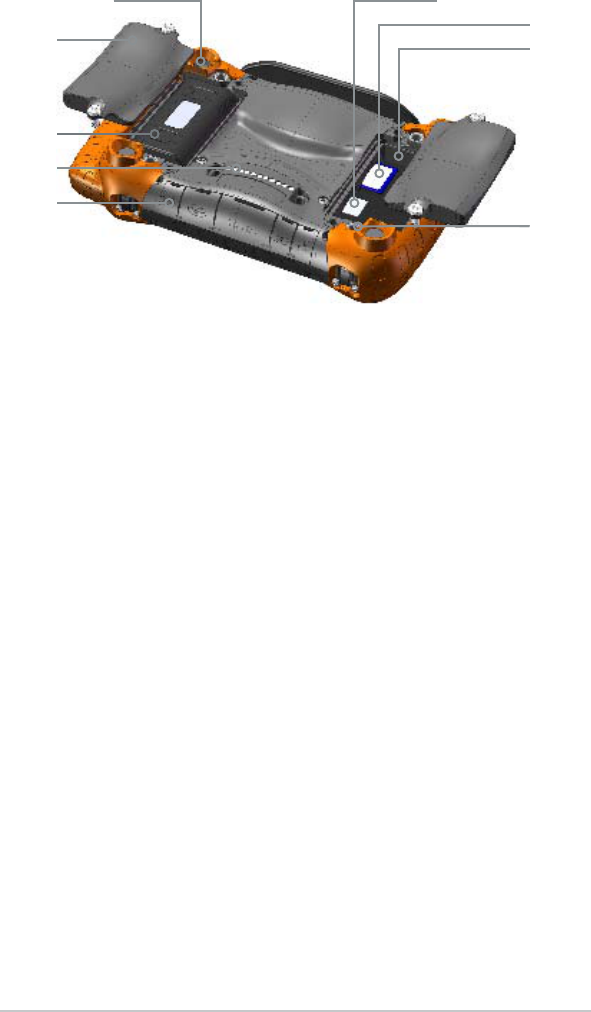
Ch 1 Getting Started 7
Mesa Back View: Battery Compartments, Card Slots
1
2
3
4
5
6
7
8
9
1 Camera lens (Geo model)
2 Battery door with quarter turn latches
3 Battery compartment #2 (battery pack installed)
4 Mobile Dock connections
5 Connector protector
6 SIM card slot
7 SD card slot
8 Battery compartment #1
9 External accessory mount (4 on back)
1
2
3
4
5
6
7
8
9
1 Camera lens (Geo model)
2 Battery door with quarter turn latches
3 Battery compartment #2 (battery pack installed)
4 Mobile Dock connections
5 Connector protector
6 SIM card slot
7 SD card slot
8 Battery compartment #1
9 External accessory mount (4 on back)
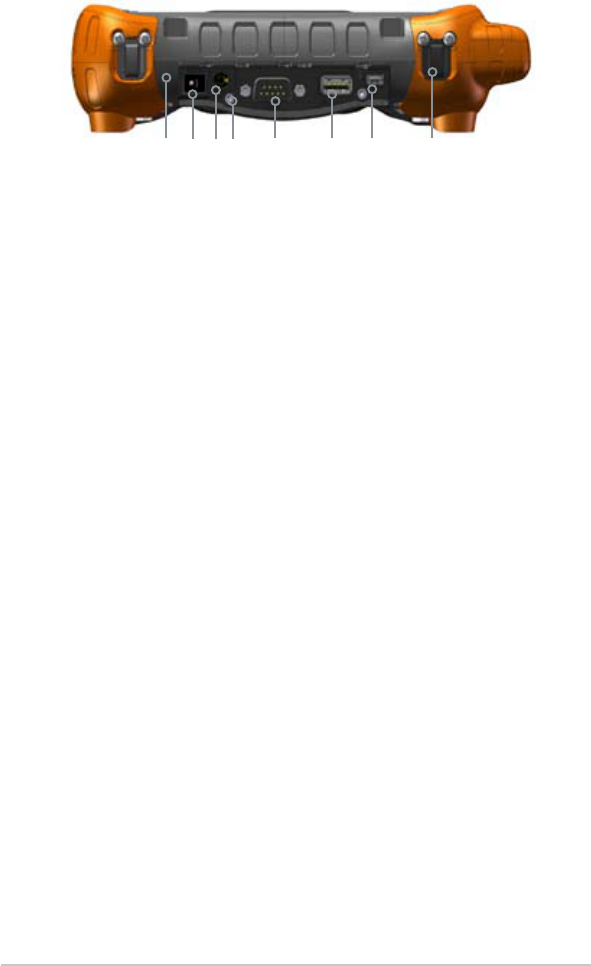
8 Mesa Rugged Notepad Owner’s Manual
Mesa Side View, Connector Module
Performing Initial Tasks
When you receive your Mesa, perform the tasks outlined in
this section before rst use.
1 User replaceable connector module
2 12V DC power input jack
3 Audio jack
4 Cable restraint mount
5 RS-232C 9-pin D-sub connector
6 USB host, full size A
7 USB client, mini B
8 Hand strap tether (one on each corner)
654321 7 8
1 User replaceable connector module
2 12V DC power input jack
3 Audio jack
4 Cable restraint mount
5 RS-232C 9-pin D-sub connector
6 USB host, full size A
7 USB client, mini B
8 Hand strap tether (one on each corner)
654321 7 8
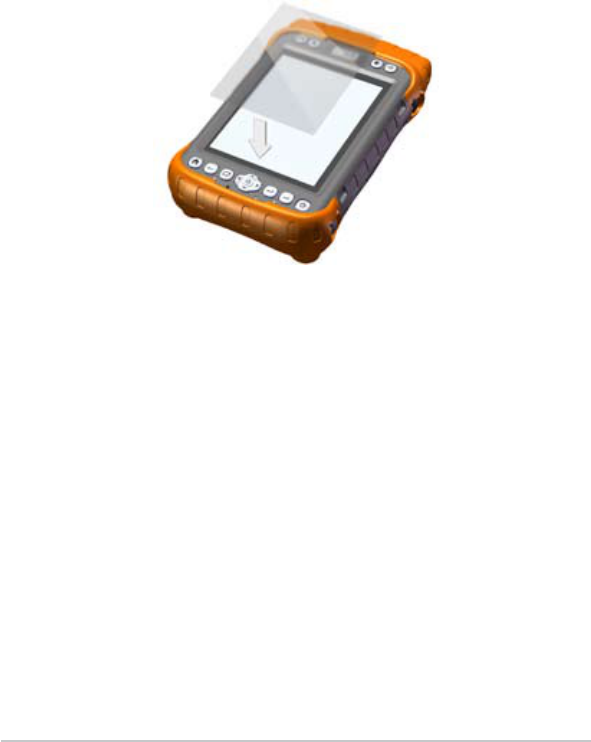
Ch 1 Getting Started 9
Apply a Screen Protector
Before using the Mesa, apply a screen protector to the surface
of the touchscreen to protect it and make it scratch-proof.
Screen protectors are included with the Mesa. Refer to the
installation instructions in the package for specic details.
1. Clean the screen with the dust-free cloth. Compressed air
can be used to blow o any remaining dust. Note: Do not
use paper towels or a cleaning solution on the touchscreen.
2. Aach the screen protector as instructed.
3. Use the installation card to push air bubbles out (it may
take a few days for air bubbles to get worked out).
4. Never use sharp objects to adjust or remove the screen
protector.
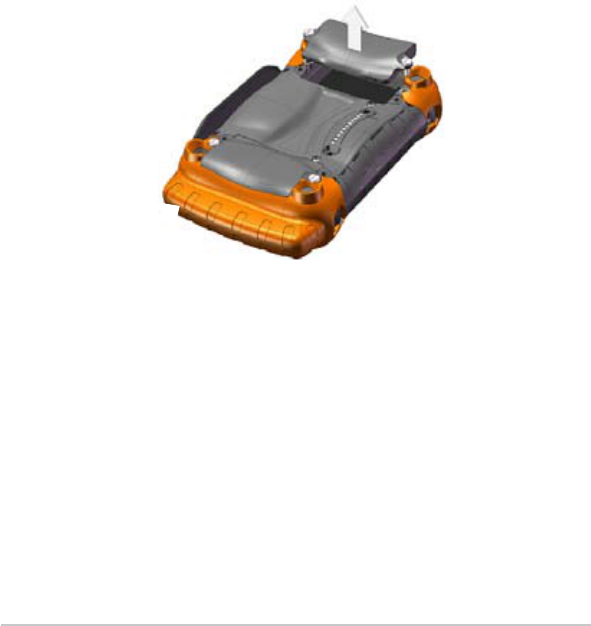
10 Mesa Rugged Notepad Owner’s Manual
Charge the Battery Pack(s)
Install and charge the Li-Ion baery pack(s). The Mesa is
designed to use 1 or 2 baery packs. Using two baery packs
extends the operating time of the unit. Geo 3G models should
always use two baery packs.
Complete the following steps:
1. The baery compartments are located on the back of the
Mesa. Loosen the quarter turn latches holding the baery
compartment door(s) in place using a coin or similar object
(loosen them enough to slightly li the door, making it
easier to grab). Remove the door(s).
Note: If you are using one baery, for the best ergonomics we
recommend you use baery compartment #1 on the boom
designated for baery 1 as shown in the following graphic.
2. Place the Li-Ion baery pack(s) in the compartment(s). Make
sure the connectors on the baery pack(s) line up with the
connectors inside the compartment(s).
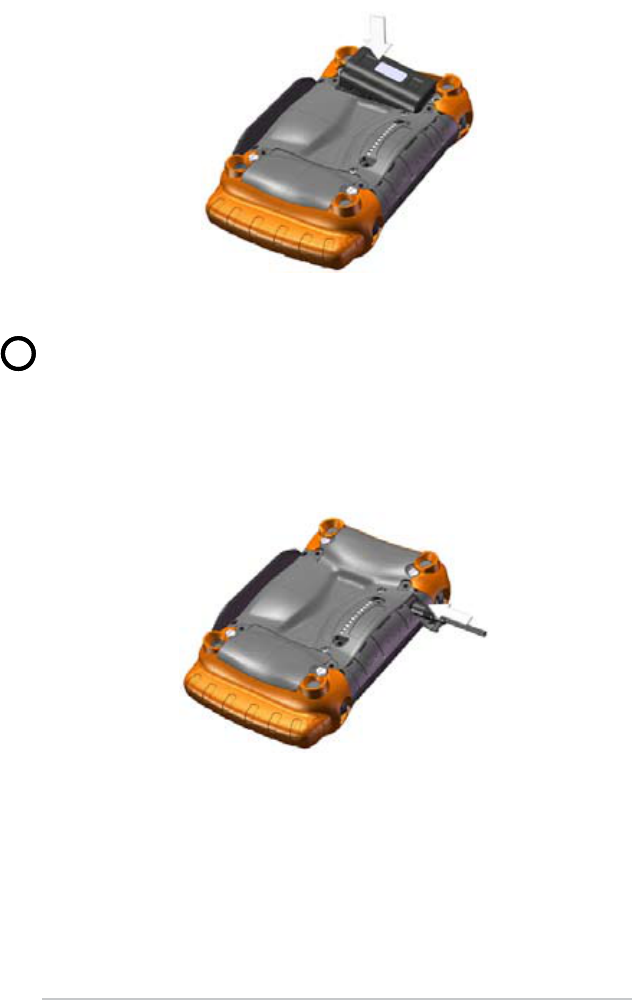
3. Replace the door(s) and tighten the latches.
CAUTION: The Mesa is not totally sealed against water and
dust when baery doors are not installed and properly
latched.
4. Plug the AC wall power charger that came with the Mesa
into a wall socket. Plug the other end into the DC power
jack on the Mesa.
!!
Ch 1 Getting Started 11
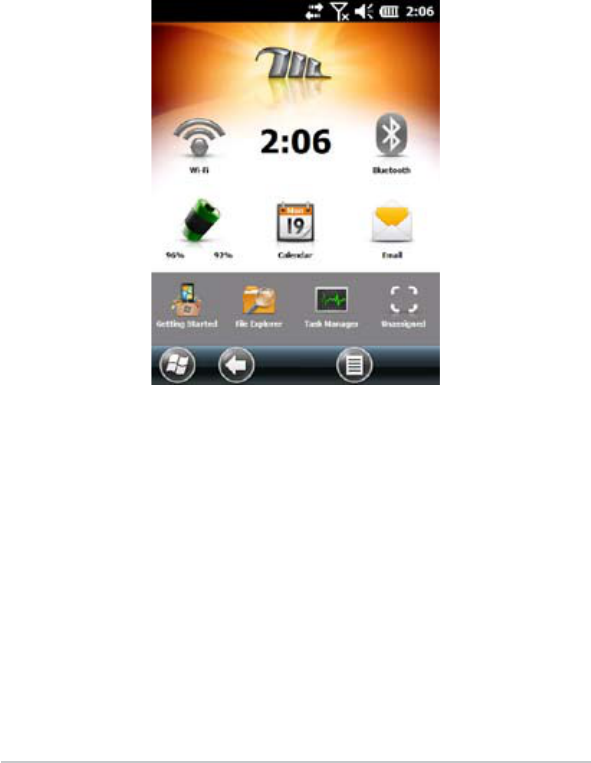
12 Mesa Rugged Notepad Owner’s Manual
Perform Set Up
1. The Mesa powers on and begins the startup process. A
progress indicator is shown on the screen.
2. Follow the on-screen instructions.
3. The Clock and Alarms control panel is shown. Adjust the
time zone, date and time if necessary and tap OK.
4. Tap on the screen again to complete the set up process.
5. The Home screen appears.
10. Charge the baery pack(s) at room temperature (68° F or
20° C) for 2 to 3 hours if you are using one pack and 4 to 6
hours if you are using 2 packs.
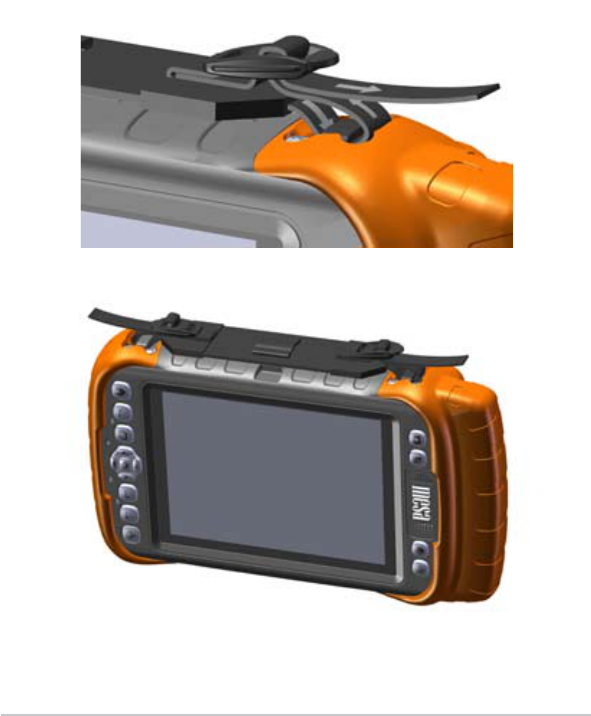
Adjust the Hand Strap
A hand strap is included with the Mesa. It is aached to the le
side of the Mesa along with a stylus, leaving your right hand
free to operate the Mesa. Put your hand between the strap
and the Mesa from the front and adjust the hand strap to t
securely against the back of your hand.
You can move the hand strap to dierent locations to meet your
needs. There are four hand strap tethers (one on each corner).
Your hand strap can be aached and threaded in a manner
similar to the drawings shown below.
Ch 1 Getting Started 13

14 Mesa Rugged Notepad Owner’s Manual
Review the Manual
Once you have aached a screen protector, charged the baery
pack(s), and adjusted the hand strap the Mesa is ready to use.
Review the rest of this manual to learn about the functionality
of the Mesa.
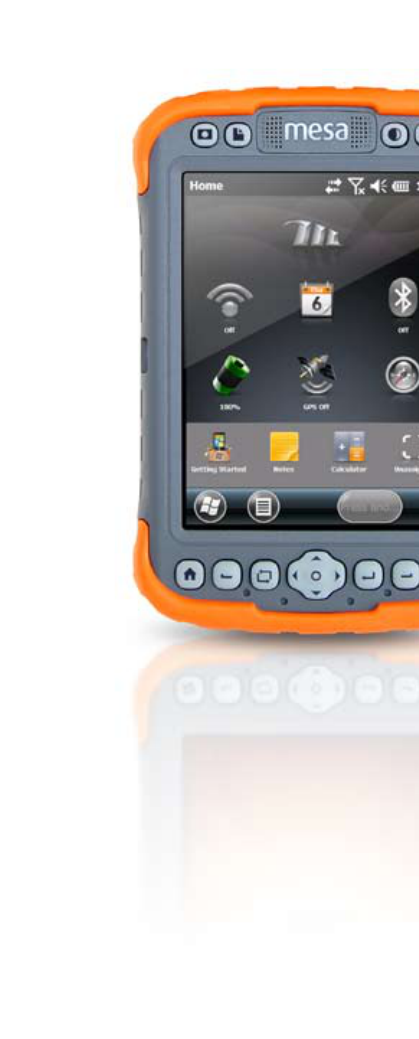
2
Hardware
Components
16 Navigating Around Your Mesa
17 Home Screen and Windows Start
Menu
18 Display and Touchscreen
20 Keypad Features
24 Power Management
26 LED Activity Indicators
26 SD Cards
27 Connector Module
28 Audio Features

16 Mesa Rugged Notepad Owner’s Manual
Mesa Hardware Components
This chapter discusses the Mesa Rugged Notepad hardware
features and usage.
Navigating Around Your Mesa
Using Gestures and Making Selections
The Windows® Mobile operating system enhances the Mesa’s
ability to recognize touch gestures, making it easy to use
a nger to navigate. The Mesa buons can also be used.
Navigation options vary depending on the screen you are on.
Here is a partial list of options:
Vertical and Horizontal Movement
1. Flick up, down or sideways on the touchscreen.
2. For more precise positioning, touch, hold, and move the
screen in the desired direction.
3. Use the scroll bar if it is available.
4. Use the arrow buons on the ve-way directional buon.
5. On control panels press the le or right arrow keys at the
top of the screen to scroll horizontally (this feature replaces
tabs).
Making a Selection
1. Press or tap the item you want to select, turn on, or activate.
2. Press and hold an icon to bring up a conguration screen,
menu, or list.
3. Press the action buon in the center of the ve-way
directional buon.
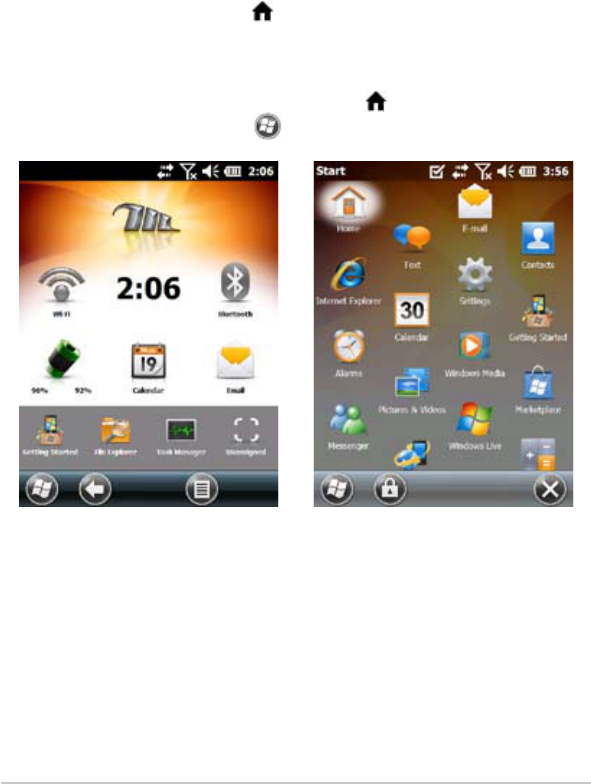
Home Screen and Windows Start Menu
There are two screens you need to be aware of as you read this
manual and use the Mesa: the Home screen and Windows Start
menu.
The Home screen is your main control center for the Mesa. The
content varies based on which model you have and can be
customized. It is automatically shown when the Mesa is turned
on. You can get to it from any other screen by pressing and
releasing the Home screen buon.
The Windows Start menu gives you access to all of the
applications on the Mesa. You can get to it from any screen by
pressing and holding the Home screen buon or tapping
the Windows so key (tile) on the display.
More information about these screens is located in Chapter 3,
Programs and Seings.
Home Screen Windows Start Menu
Home Screen Windows Start Menu
Ch 2 Hardware Components 17
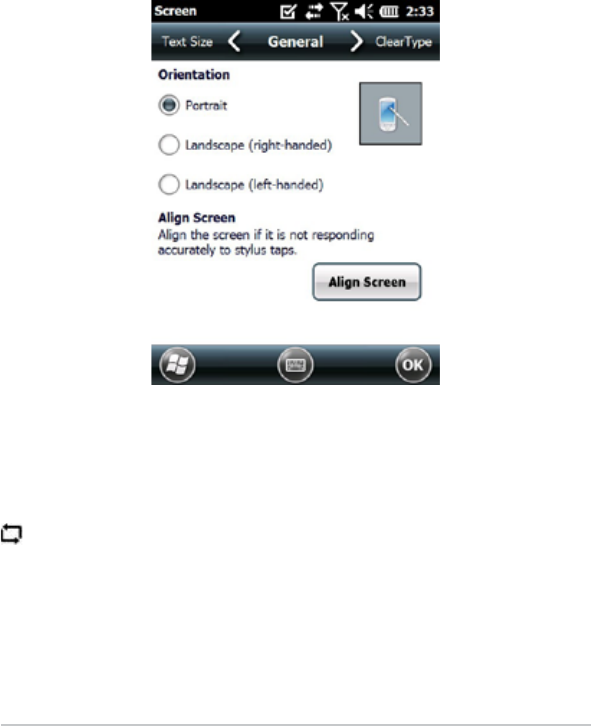
18 Mesa Rugged Notepad Owner’s Manual
Display and Touchscreen
The Mesa has a bright color display and touchscreen with a
diagonal viewing area of 5.7 inches (145 mm). It is easy to view
outdoors and sealed against water and dust.
Adjusting Display Settings
To adjust the default display seings including the text size,
alignment and orientation, go to the Screen control panel, Start
> Seings> System > Screen. There are also shortcuts to some of
the seings described in the text that follows.
Screen Orientation
The Mesa screen can be used in either portrait or landscape
mode. The default is portrait mode. To switch the screen
orientation, press and release the screen orientation buon
. The default landscape orientation is right-handed. To select
le-handed orientation, go to Start > Seings > System > Screen.
Screen Alignment
The Mesa touchscreen is precalibrated. If it needs to be
adjusted, tap the Align Screen buon and follow the prompts.
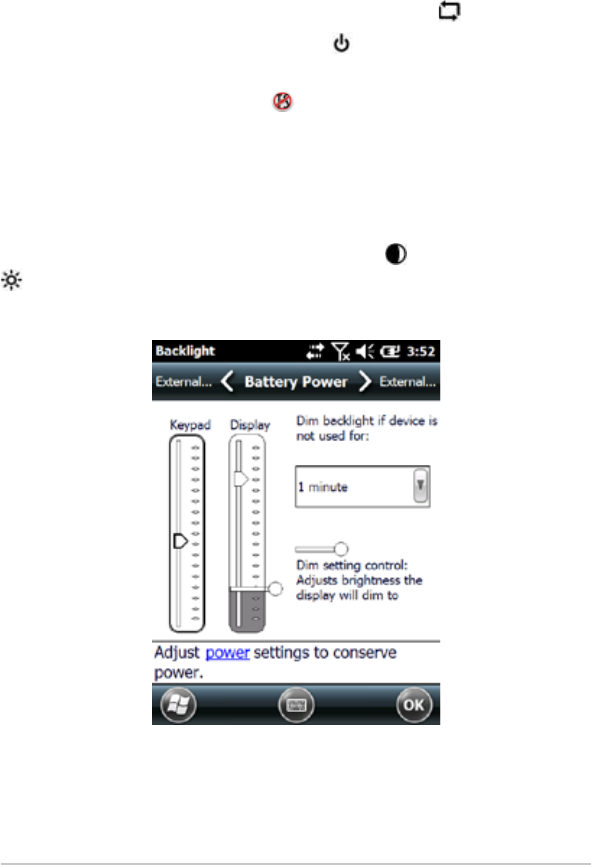
Disabling and Enabling the Touchscreen
You can disable the touchscreen. This is useful when you are
running an application and you want to see the screen, but you
want to avoid accidental touchscreen activation. It can also be
disabled for cleaning purposes. Options:
Press and hold the screen orientation buon .
Press and hold the power buon to bring up the Power
Buon menu. Select Disable TS.
The touchscreen disable icon is shown in the title bar until
the touchscreen is enabled again.
Adjusting the Display Backlight
Dimming or turning o the display backlight saves baery
power when the device is running. Adjust the display
brightness by using the brightness down and brightness up
buons. You can also make brightness adjustments through
the Backlight control panel, Start > Seings> System > Backlight.
The display has a minimum brightness seing that it dims
to when the Mesa is not in use. Power is conserved, yet the
Ch 2 Hardware Components 19
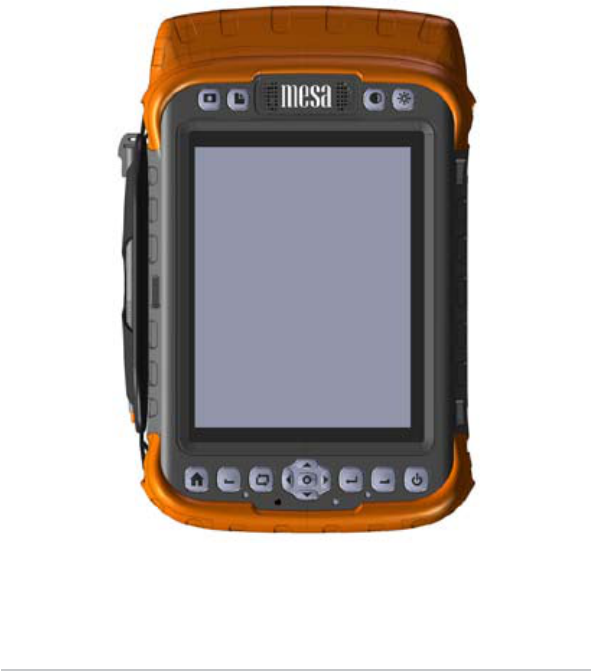
20 Mesa Rugged Notepad Owner’s Manual
display is still partially visible. Adjust the dim time interval
and seing as needed. To use the Mesa, tap on the display to
bring the display backlight back up to the brightness seing.
Keypad Features
The Mesa has een buons with symbols indicating their
functions as shown below. Features include:
Top row: four function buons
Boom row: eleven navigation buons
Six reassignable buon functions
Buons are sealed and backlight illuminated
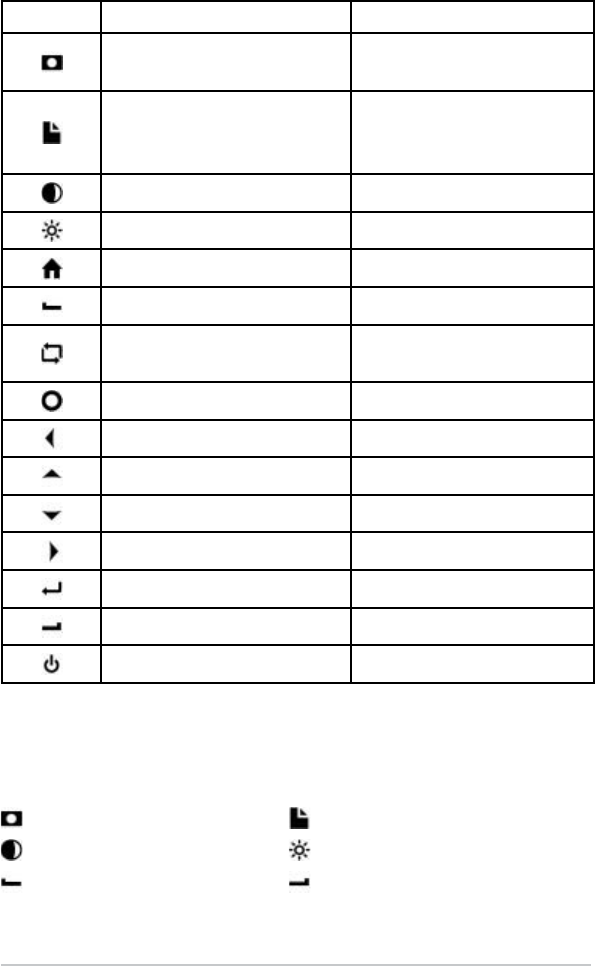
Buons and their functions:
Buon Press and Release Press and Hold
Camera (Geo models) or
Pictures and Videos (Std)
Task Manager
Notes Record Audio Note
(press and hold to
record, press to stop)
Screen Brightness Down <Repeat Key>
Screen Brightness Up <Repeat Key>
Home Screen Start/Windows Screen
Le So Key No Function
Rotate Screen Touchscreen Disable/
Enable
Action Done/OK
Le <Repeat Key>
Up <Repeat Key>
Down <Repeat Key>
Right <Repeat Key>
Enter Done/OK
Right So Key No Function
Power, Suspend/Resume Power Buon Menu
Reassignable Button Functions
The press and release functions of the following buons can
be reassigned allowing you to create unique shortcuts and
directly open specic programs that you use oen:
Camera/Pictures Notes
Brightness Down Brightness Up
Le So Key Right So Key
Ch 2 Hardware Components 21
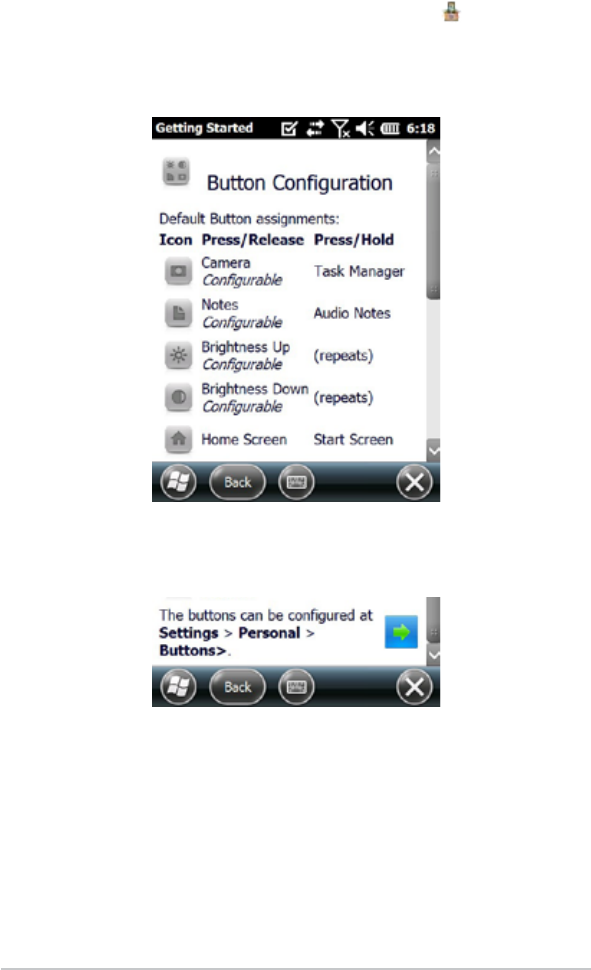
22 Mesa Rugged Notepad Owner’s Manual
Follow these steps to reassign buon functions:
1. From the Home screen, tap Geing Started . If Geing
Started is not on your Home screen, go to Start > Seings >
Personal > Buons. Select Congure Buons from the list. A
list of default buon assignments is displayed.
2. Scroll to the boom of the screen. Select the shortcut to
Seings > Personal > Buons.
3. A list of reassignable buons is shown in 1. Select a buon.
Select the buon you want to reassign.
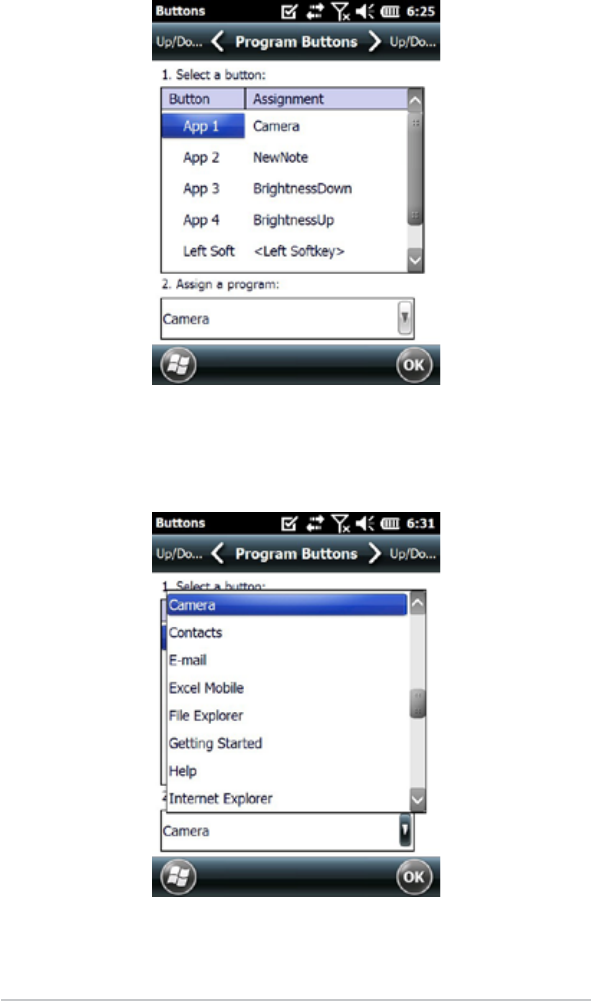
5. Select the down arrow buon shown in 2. Assign a program.
6. A list of programs is shown. Select the program you want
to reassign to the selected buon. Tap OK.
Ch 2 Hardware Components 23

24 Mesa Rugged Notepad Owner’s Manual
Power Management
The Mesa uses 1 or 2 Li-Ion rechargeable baery packs.
Battery Life
Baery life on a full charge is generally up to eight hours per
pack (this can vary signicantly depending on the application,
backlight usage, and radio usage).
Baery packs last approximately 300-500 charging cycles. This
is impacted by the use conditions, environment, etc.
Charging Battery Packs
To charge baery packs, refer to the instructions in Chapter 1,
Geing Started. It typically takes 2 to 3 hours to fully charge 1
baery pack and 4 to 6 hours to charge 2 baery packs.
We recommend that you keep the Mesa baery pack(s)
charging when they are not in use for up to two weeks. When
you plug the Mesa into the wall charger that comes with the
Mesa or the optional Travel Charger, the baeries are prevented
from being overcharged.
Mesa Li-Ion baery packs are charged most eciently at
room temperature (68°F or 20°C). Only charge baery packs in
temperatures between 32°F and 104°F (0°C and 40°C).
CAUTION: The Mesa is not totally sealed against water and
dust when baery doors are not installed and properly latched.
Adjusting Power Settings
You can view and adjust the power seings from the Power
control panel. From the Home screen tap the baery gadget.
You can also go to Start > Seings > System > Power or tap on the
top title bar from any screen and select the baery icon in the
scrollable list of applications that drops down. A Power control
panel with a graphic representing baery status similar to the
following is shown:
!!
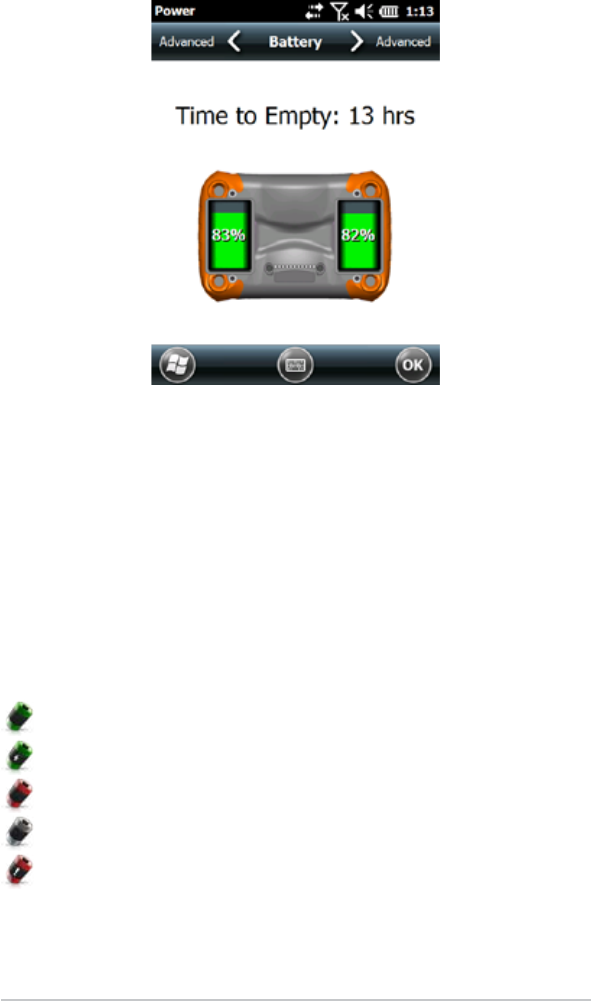
Go to the Advanced set up screen to select how long the Mesa
should stay on when it is not in use. As mentioned under
“Adjusting the Backlight,” dimming the display backlight saves
baery power. Radios can also use a lot of power. You can
conserve power by disabling them when not in use from the
Home screen or Start > Seings > Connections.
Viewing Battery Status
You can view the status of the baery pack(s) from the Home
screen if the baery gadget is enabled. Depending on the status
of the baery pack(s), one of the following icons is shown:
Baery pack(s) power as a percent
Baery pack(s) charging
Baery pack(s) low
External power in use
Charging error
Ch 2 Hardware Components 25

26 Mesa Rugged Notepad Owner’s Manual
Charging Errors
Charging errors are caused by the following:
Baery pack(s) is too hot to charge
Baery pack(s) is too cold to charge
Cannot charge for unknown reason
If you have a charging error, make sure the baery pack(s) is
inserted correctly, the baery door(s) is closed properly, and
you are within the charging temperature range.
LED Activity Indicators
There are LED activity indicators located underneath the
boom row of buons that indicate the following:
Red, solid: Waiting to boot/startup, nished charging (when
external power is applied)
Red, blinking: External power applied, charging
Green: Suspend and resume notication
Blue: Not shown unless programmed
The blue and green LEDs are user programmable through
application soware.
SD Cards
The Mesa has a slot for an SD card located in baery
compartment 1. To insert or remove a card follow these steps:
1. Suspend or power o the Mesa if the only power source is
from a baery pack in baery compartment 1.
2. Loosen the screws to baery compartment 1 and remove
the door.
CAUTION: The Mesa is not totally sealed against water
and dust when baery doors are not installed and properly
latched.
3. Remove the baery pack.
!!
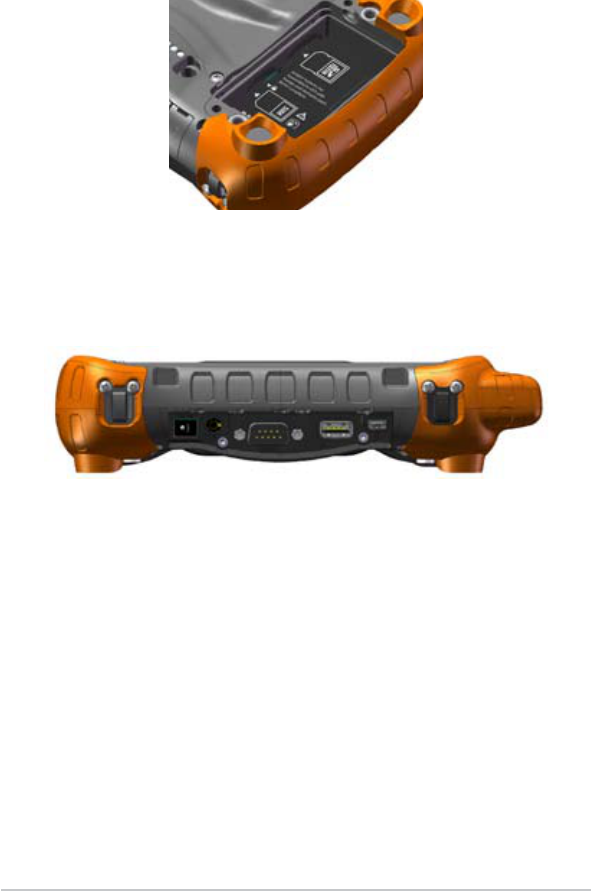
4. An image on the baery compartment label shows the
correct location and orientation for the card. Push the SD
card into the slot to insert it. To remove an SD card, push it
into the slot then release it to eject the card.
5. Replace the baery pack and aach the baery door.
6. Resume the Mesa if it was suspended in step 1.
Connector Module
The Mesa has the following jacks and connectors:
Power input jack, 12 VDC for power input and baery
charging
Microphone/Speaker jack: 3.5mm, supports speaker/mic or
stereo output (speaker cuto)
RS-232C 9-pin D-sub connector, 5 V @500 mA available on
DTR pin 4 and pin 9 under program control
USB host, full size A
USB client, mini B
The connector module is user-replaceable. A connector
protector covers the ports to keep debris out.
Ch 2 Hardware Components 27
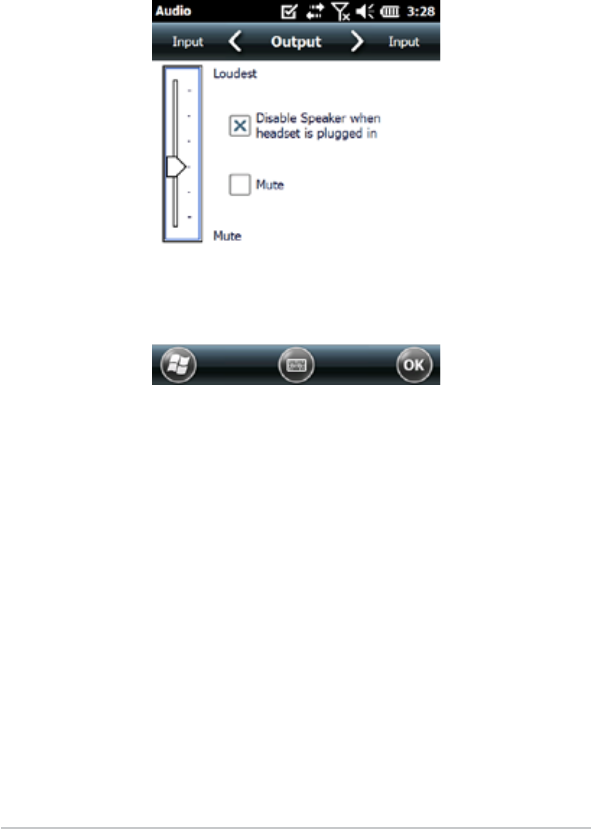
28 Mesa Rugged Notepad Owner’s Manual
Audio Features
The Mesa has a speaker, microphone, and audio jack. To adjust
audio seings, select the top title bar, then the speaker icon
from the horizontal-scrolling list that appears. You can also
go to Start > Seings > System > Audio. The Audio control panel
appears.
Speaker
The speaker sound is loud and clear. Listen to audio notes,
video sound, and music les.
Microphone
Use the microphone to record audio notes or add sound to a
video when using the camera function (Geo units).
Audio Jack
The audio jack supports a stereo headset or headset/
microphone combination with 3.5mm connections. The
onboard speaker and microphone can be disabled when a
headset is plugged in.
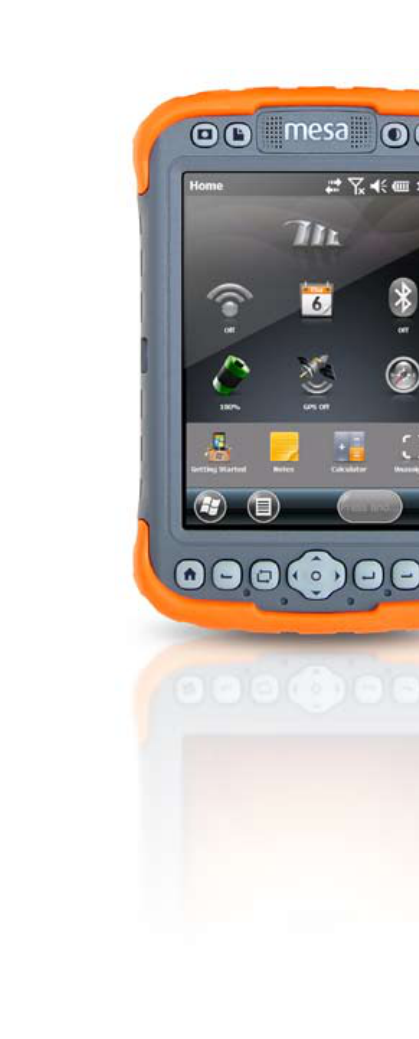
3
Programs
and Settings
30 The Home Screen
35 Suspend, Reset, Power O,
Restore the Mesa
37 Communicating with a Desktop
Computer
38 Getting Started Screen and
Online Help
40 Information for Software
Developers
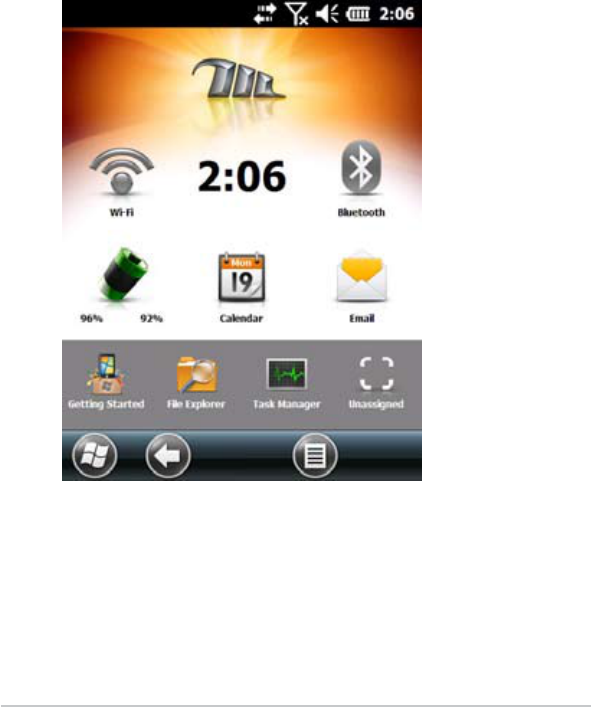
30 Mesa Rugged Notebook Owner’s Manual
Mesa Programs and Setting
This chapter discusses the Mesa Rugged Notepad programs
and seings.
The Home Screen
The Home screen is your main control center for the Mesa.
View vital system information and quickly access functions
and applications that are frequently used. The default home
screen for a basic unit is shown below. If you have a Geo model
or a cellular modem, dierent functions are shown. You can
customize the Home screen.
Title Bar and Status Icons
The title bar is at the top of every screen. It identies the page
and shows status icons indicating functions like connectivity
status, audio, power, and time. Tap the title bar to bring up
Title Bar
Dashboard
Favorites Bar
Tile Bar
Title Bar
Dashboard
Favorites Bar
Tile Bar
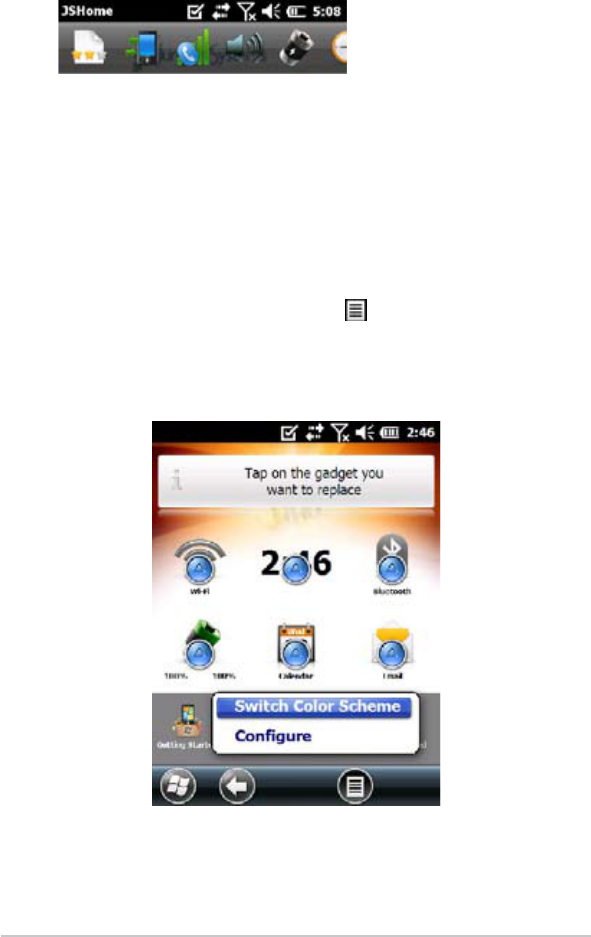
larger, touchable icons in a horizontal-scrolling bar. Select a
function to view the seings and adjust them as desired.
Dashboard
The dashboard consists of a background image and up to six
dashboard gadgets that serve as functional indicators and
control buons.
In most situations, tap on a gadget to turn a function on/o.
Tap and hold to go to a control panel or launch an application.
You can switch between two color schemes and select which
gadgets are shown. Tap on the menu so key and select
Switch Color Scheme to change color schemes or Congure to
select gadgets. The current gadgets are covered with a blue
symbol as shown below. Tap on the gadget you want to replace.
Pop Up Status Icon Bar
Title Bar
Pop Up Status Icon Bar
Title Bar
Ch 3 Programs and Settings 31
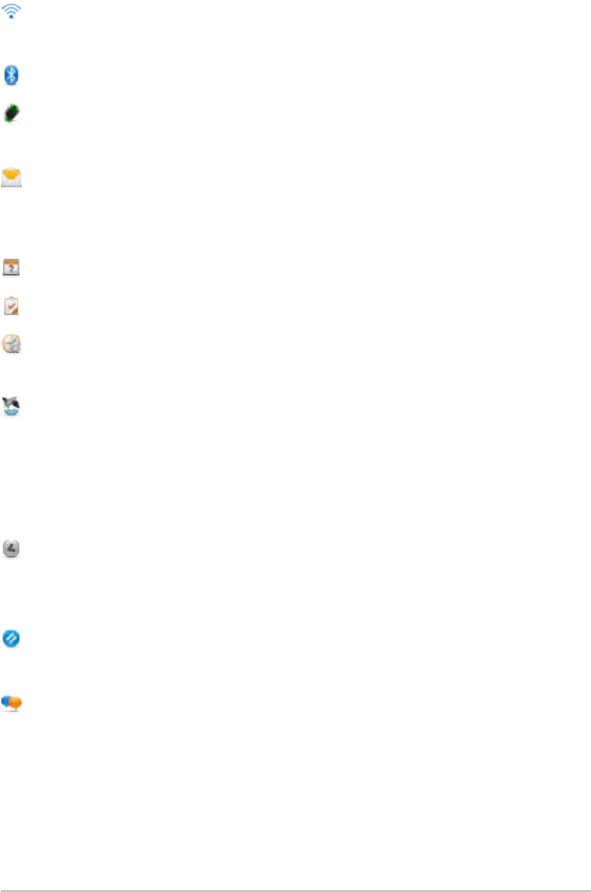
32 Mesa Rugged Notepad Owner’s Manual
A list of available dashboard gadgets is shown. Tap on your
selection. The dashboard icon changes when you make a
selection. If “None” is selected, the space becomes blank.
Dashboard Gadget Functions
Wi-Fi: Shows the state of the Wi-Fi radio and provides the
name of the wireless network that it is aached to.
Bluetooth: Shows the state of the Bluetooth radio.
Baery Status: Shows the status of the current baery
pack(s).
Email: Shows the current number of unread email
messages. If there are multiple email accounts, the total
number of unread messages is aggregated from all accounts.
Calendar: Shows the next appointment.
Tasks: Shows the current number of tasks.
Clock and Alarms: Shows the current time and date. Tap to
set a reminder alarm.
GPS Status (Geo model): Shows the current state of GPS
reception and the state of the GPS receiver. It also shows the
number of satellites in view, the number of satellites used
to calculate the x (SV), the type of x (2D, 3D, etc) and the
quality of the x (PDOP).
GPS Compass (Geo model): Provides the function to mark
a waypoint and navigation (bearing, heading, distance) to a
marked waypoint.
3G Data Modem: (Geo model with cell modem): Shows the
on/o state of the optional cellular modem.
Texting (Geo model with cell modem): Shows the current
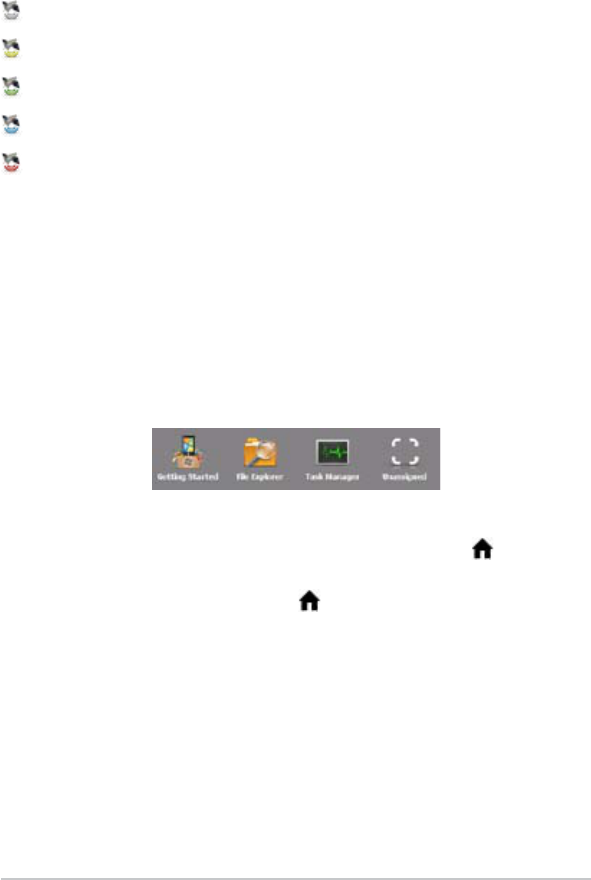
number of unread text messages.
Gadget Color Indicators
Wi-Fi, Bluetooth, GPS and 3G data modem gadgets indicate
status using these colors:
Gray: O or inactive
Yellow: Partial state (geing satellite x, etc.
Green: Active and available
Blue: Notication state (on or connected)
Red: Error state, powering up or down, no GPS x, or
unavailable (3G data modem is red when power is changing
from on/o. Wi-Fi is red when an access point is available, but
not connected.)
Favorites Bar
The favorites bar consists of shortcuts to specic applications.
It is located below the dashboard when the screen is in portrait
mode and to the side of the dashboard when it is in landscape
mode. Tap on a shortcut icon to launch an application.
You can use it to jump between the applications you use most.
While running an application, press the home key and select
a dierent application from your favorites. To return to the rst
application, press the home key again, then tap on the rst
Ch 3 Programs and Settings 33
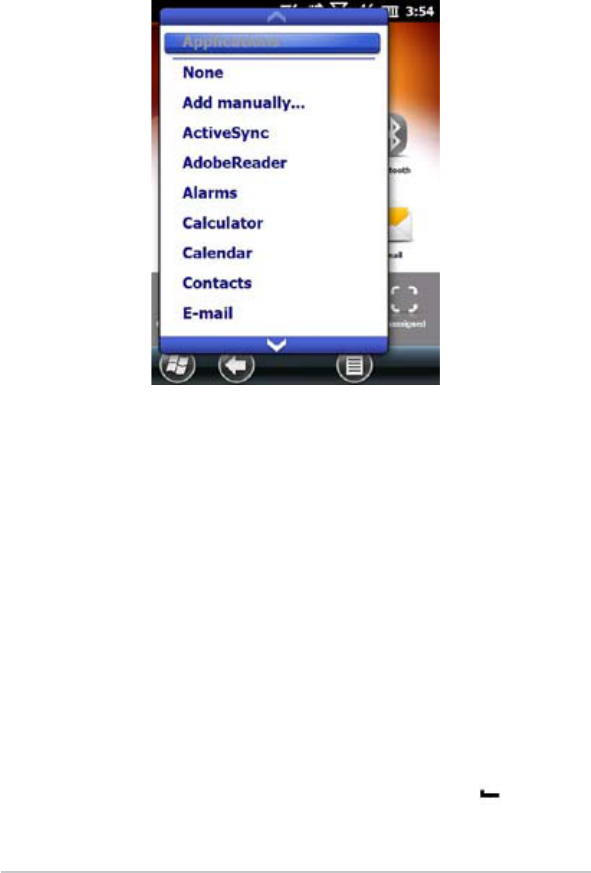
34 Mesa Rugged Notepad Owner’s Manual
application you were running.
You can customize which application shortcuts are shown. Tap
and hold on the shortcut you want to change to bring up a list
of available applications.
Tap on your selection. The icon on the home screen changes to
the icon associated with the new application.
Tile Bar
Touchable tiles (or so keys) are shown in the tile bar at the
boom of each screen. For the Home screen, the tile bar
consists of the start tile that takes you to the Start menu, the
back tile that takes you to the last application that was running,
and the menu tile that gives you the ability to customize
dashboard.
Touchable Tiles
There is space for ve touchable tiles on a tile bar. They
function as dened for Windows Mobile and the active
application. Tap on tiles to perform actions or open associated
menus or set up screens. You can also press the le so key
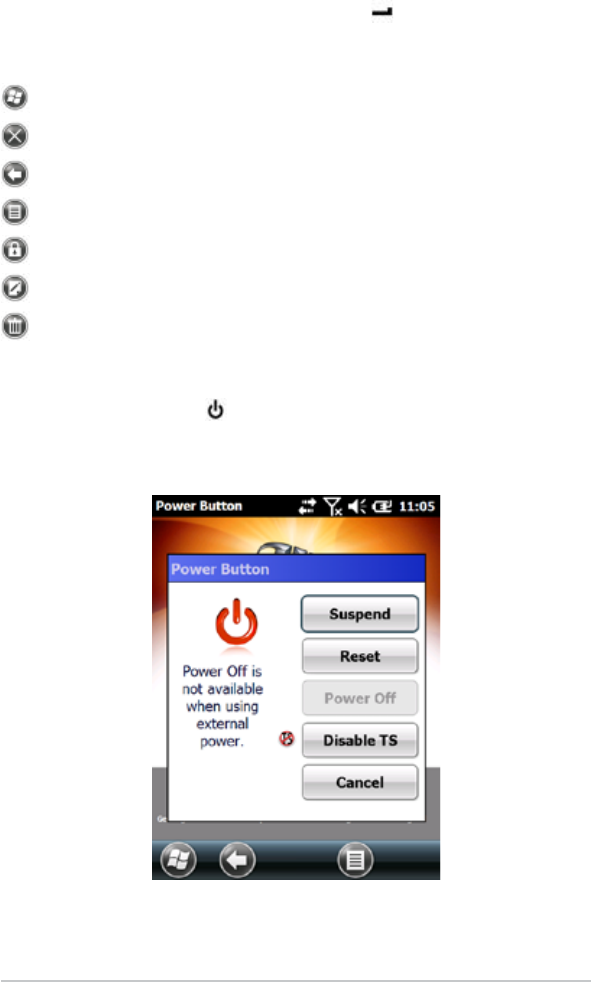
(buon) on the Mesa’s boom navigation keypad to select the
tile in the second position and the right so key to select the
tile in the fourth position. Tile examples:
Start
Close
Navigate back
Menu
Lock
Edit
Delete
Suspend, Reset, Power O, and Restore the Mesa
Use the power buon and the power menu to suspend,
reset, power o or restore the Mesa. To access the power buon
menu, press and hold the power buon.
Ch 3 Programs and Settings 35

36 Mesa Rugged Notepad Owner’s Manual
Suspending and Resuming the Mesa
We recommend suspending your Mesa if you plan to turn it
o for less than two weeks. While it is suspended, you should
aach it to a wall charger when not in use.
Suspending the Mesa is dierent from powering it o. When
the device is suspended it goes into a very low power mode.
When it is resumed, the Mesa resumes where it was before it
was suspended.
To suspend your Mesa, press and release the power buon. To
resume the device from suspend mode, press and release the
power buon again.
When the Mesa starts to suspend, the backlight shuts o and
the green LED turns on. It can take several seconds to fully
suspend, especially when the cell modem is on.. The green LED
turns o when suspend is complete. Some baery power is
used during suspend.
Resetting the Mesa
It can be helpful to reset the Mesa when it is unresponsive,
slow, or programs won’t launch. You may be asked to perform
a reset when an application is installed.
CAUTION: Be aware that during a reset, applications are
terminated and unsaved work may be lost.
Follow these steps to reset your Mesa:
1. Save your open les and close any running programs.
2. Press and hold the Power buon until the Power Buon
menu appears.
3. Choose Reset.
You can also reset the Mesa by pressing the power buon for
10 seconds or until the screen goes dark. Aer a few seconds,
the Mesa automatically turns on. This method is useful if your
Mesa locks up.
!!

Powering O and Powering On the Mesa
To preserve baery power, we recommend you power o the
Mesa if it will not be used for two weeks or longer.
CAUTION: Be aware that when the Mesa is powered o, it
closes all programs and powers down all system components
except for the real-time clock. Unlike suspend mode, the device
resets when it is powered on again. Any unsaved data is lost.
1. Save all open les and close any running programs.
2. Press and hold the power buon until the power menu
appears.
3. Tap Power O. A warning dialog appears. Tap OK.
To power on your Mesa, press the power buon.
Restoring the Mesa to its Factory State
Follow the steps below to restore user storage, seings, and
icons on your Mesa to their original factory defaults.
CAUTION: Restoring the Mesa to its original factory state
permanently erases data saved on the Mesa, any soware you
installed, and any changes you made to the Mesa (including
seings changes).
To restore factory defaults (clean boot), press and hold the
rotate + up + return buons simultaneously. The rst
tick mark lights up and the Mesa looks to see if these keys are
being pressed. If so, the backlight dims and the boot process
stalls until all these keys are released. The backlight returns to
normal brightness and the boot process continues.
Communicating with a Desktop Computer
The Mesa can connect to a desktop or laptop computer
allowing you to synchronize information and download
soware and les.
!!
!!
Ch 3 Programs and Settings 37

38 Mesa Rugged Notepad Owner’s Manual
Installing the Software
Install free synchronization soware from Microso on your
desktop computer.
1. Go to the Microso website on your PC.
2. Locate the Windows Mobile downloads section of the
website. If your computer is running Windows® 2000 or
Windows® XP, select ActiveSync® soware to download.
If it is running Windows Vista™ or Windows® 7, select
Windows Mobile® Device Center.
3. Follow the download instructions on the website.
Establishing a Partnership
1. Plug the USB Client end (mini B) of the USB
communications cable into the Mesa.
2. Plug the USB Host end (full size A) of the USB
communications cable into your desktop computer.
3. Establish an ActiveSync® or Windows Mobile® Device
Center partnership by following the instructions on the
desktop computer screen.
4. Once a partnership is established, the synchronization
soware automatically opens. Follow the steps on the
screen.
Note: For more information about connecting the Mesa to a desktop
computer using either ActiveSync® or Windows Mobile® Device
Center visit Microso’s Windows Mobile® website.
Getting Started Screen and Online Help
Getting Started Screen
The Geing Started screen provides information on current
seings, help for seing up features and applications, shortcuts
to set up screens and online help. From the Home screen tap on
the Geing Started icon to see a list of topics (or go to Start >
Geing Started >).
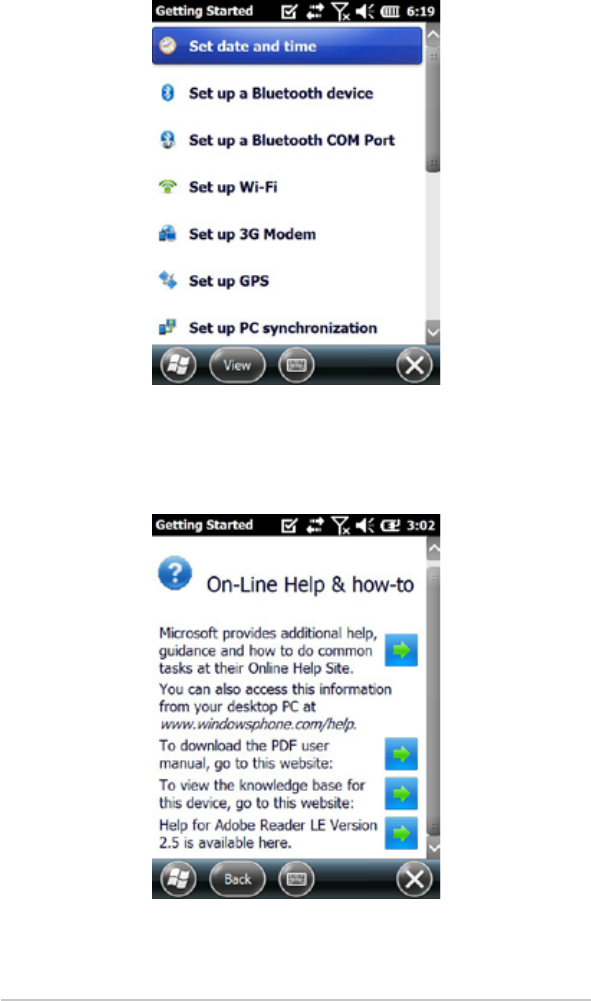
Online Help
Online help is available from Geing Started. Tap on Online
help & how-to from the list:
Ch 3 Programs and Settings 39

40 Mesa Rugged Notepad Owner’s Manual
You must be connected to the internet to access online help.
Select from the help topics.
Information for Software Developers
For Mesa SDK information, go to our website: hp://www.
junipersys.com/index.php/Juniper-Systems/support/
Developers/Mesa-Rugged-Notepad.
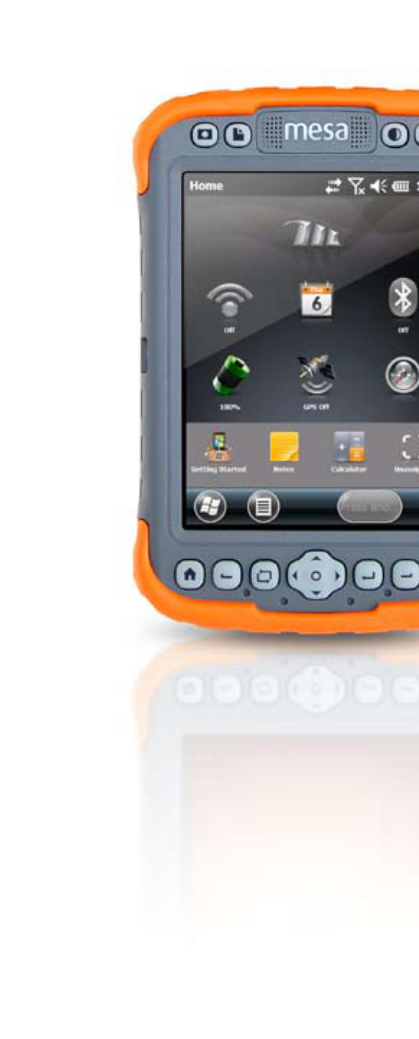
4
Bluetooth
Wireless
Communication
42 Creating a Partnership
44 Microsoft Bluetooth Control
Panel
46 Serial Device (COM) Control Panel

42 Mesa Field PC Owner’s Manual
Bluetooth® Wireless Communication
The Mesa has built-in Bluetooth® wireless technology, allowing
you to connect it to other wireless devices with Bluetooth
technology. Minimum performance between similar objects
in an unobstructed environment is approximately 100 feet (30
meters).
The Mesa provides simple conguration options for the
following types of Bluetooth devices:
1. Devices such as headphones, keyboards, and modems (to
connect to the internet with an external cell phone).
2. Serial devices that use a Bluetooth COM port such as GPS
receivers, bar code scanners, and other data collection
devices.
Creating a Partnership
To create a partnership between the Mesa and another device
with Bluetooth technology:
1. Turn both devices on.
2. Place them within at least 100 feet (30 meters) of one
another.
3. Make Bluetooth discoverable on both devices.
Bluetooth on the Mesa is on and discoverable by default.
The gadget on the Home screen turns green.
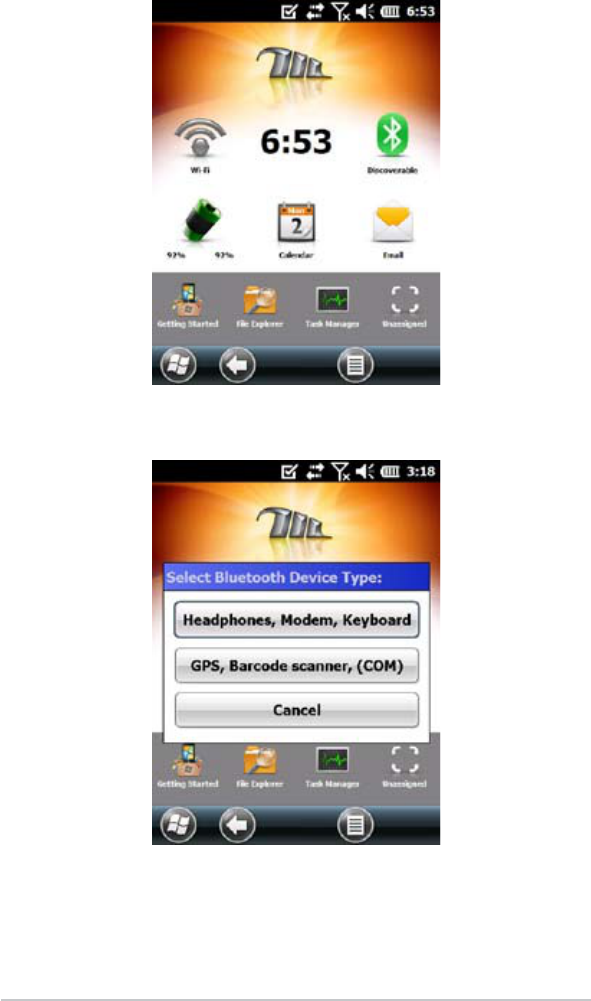
4. Tap and hold the Bluetooth icon to bring up the dialog box
shown below.
If the Bluetooth gadget is not on your Home screen, you can get
to the desired control panel by selecting Geing Started and
Ch 4 Bluetooth Wireless Communication 43
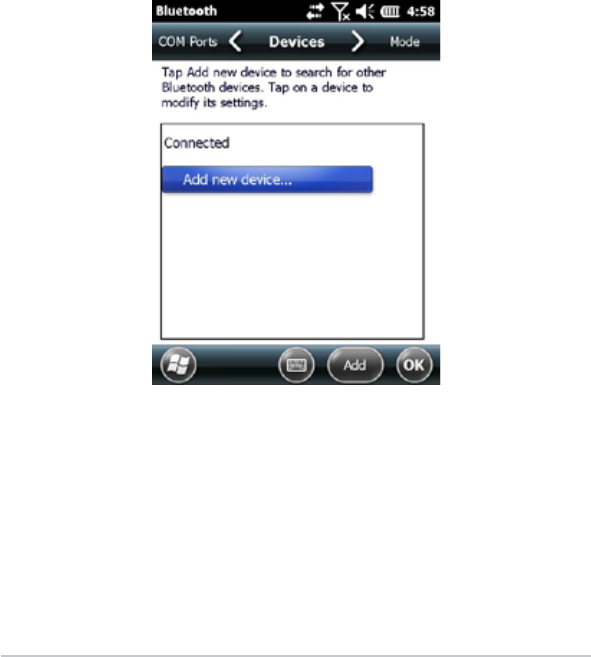
44 Mesa Rugged Notepad Owner’s Manual
either Set up a Bluetooth device or Set up a Bluetooth COM Port.
You can also go to Start > Seings > Connections.
Note: If the Bluetooth radio is turned on and then the Mesa is
suspended, wireless Bluetooth turns o to save baery power. When
the Mesa resumes (turns on), the radio turns on automatically.
Microsoft Bluetooth Control Panel
To create a partnership between the Mesa and another device
such as headphones, keyboards, and modems, follow these
steps:
1. Select the Headphones, Modem, Keyboard option. The
following Bluetooth control panel, Devices screen is shown:
2. Tap Add New Device. The Mesa searches for other devices
with wireless Bluetooth technology and displays them in a
list. Select the device you want to connect to and tap Next.
3. A passcode screen is shown.
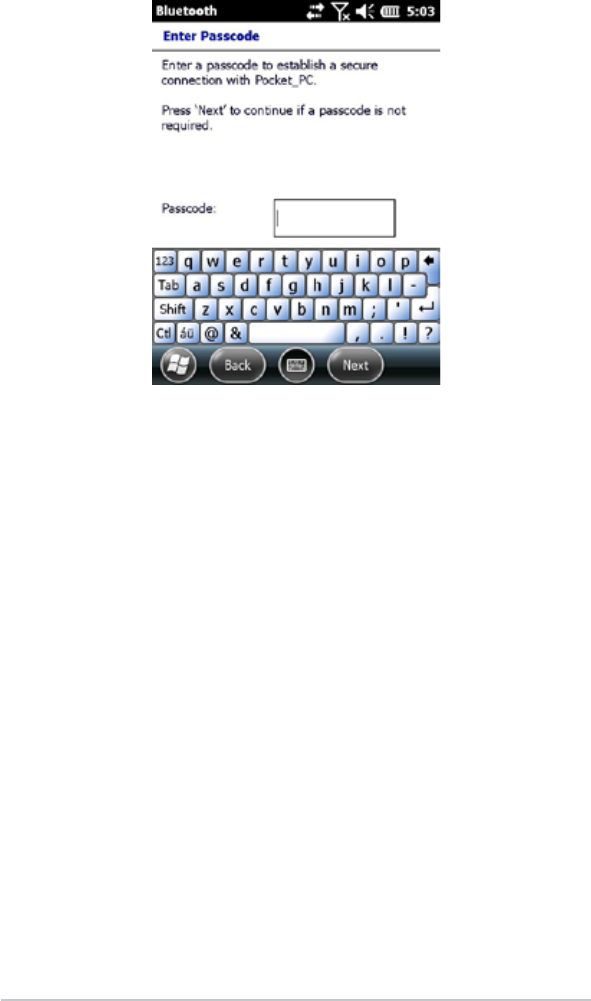
a. If the device has an assigned passcode, enter the
number and press Next.
b. If a passcode is required but has not been assigned,
enter an alphanumeric passcode between 1 and 16
characters in length. Press Next.
c. If a passcode is not required, leave the box blank and
press Next.
Note: If you are unsure whether the device requires a
passcode and whether one has already been assigned to the
device, see the user documentation that came with the device.
4. This process should connect you to the desired device.
5. Bluetooth seings can be adjusted as needed.
Ch 4 Bluetooth Wireless Communication 45
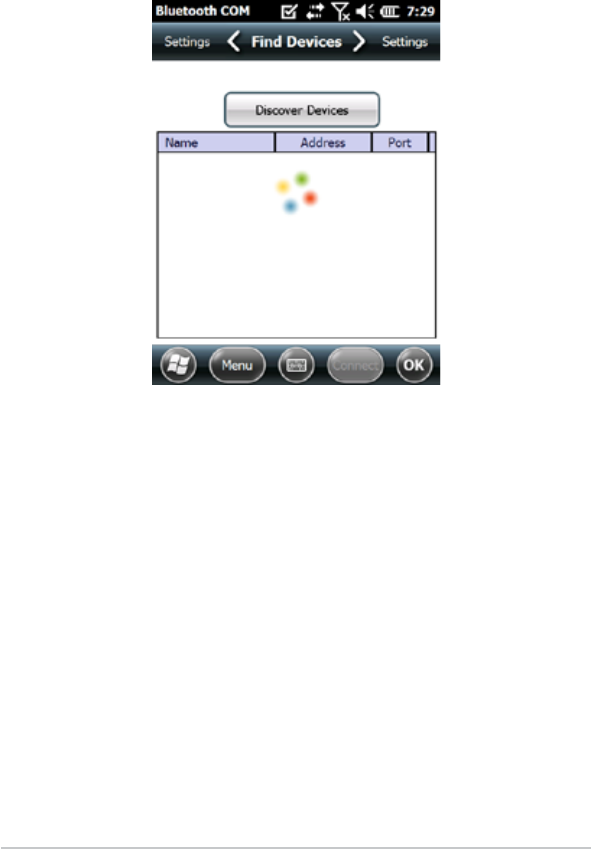
46 Mesa Rugged Notepad Owner’s Manual
Serial Device (COM) Control Panel
To set up a Bluetooth COM port, follow these steps:
1. Select the GPS, Barcode scanner (COM) option. The following
Bluetooth COM conguration screen is shown. Select
Discover Devices.
2. A list of discovered devices is shown. Select the device
you want to connect to from the list and tap Connect. A
COM port is automatically assigned for the device. You can
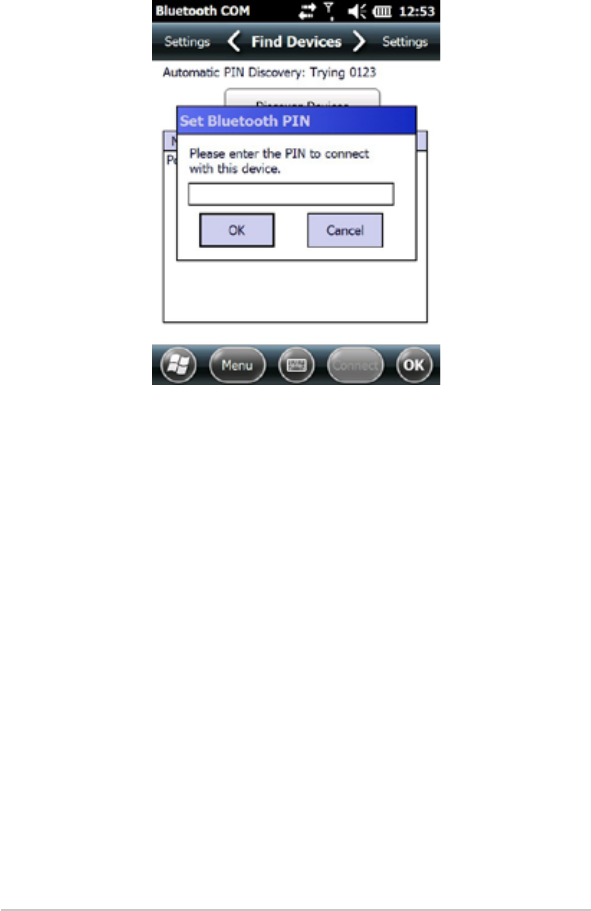
change it to another COM port.
3. The Mesa automatically tries to discover the PIN. You
might be required to enter a PIN.
4. You should now be connected to the COM device.
Ch 4 Bluetooth Wireless Communication 47

48 Mesa Rugged Notepad Owner’s Manual
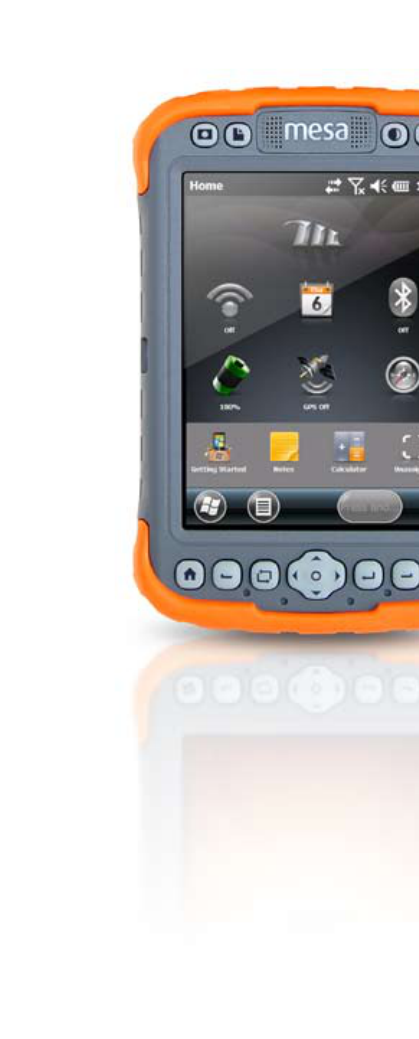
5
Wi-Fi Wireless
Communication
50 Connecting to a Wi-Fi Network
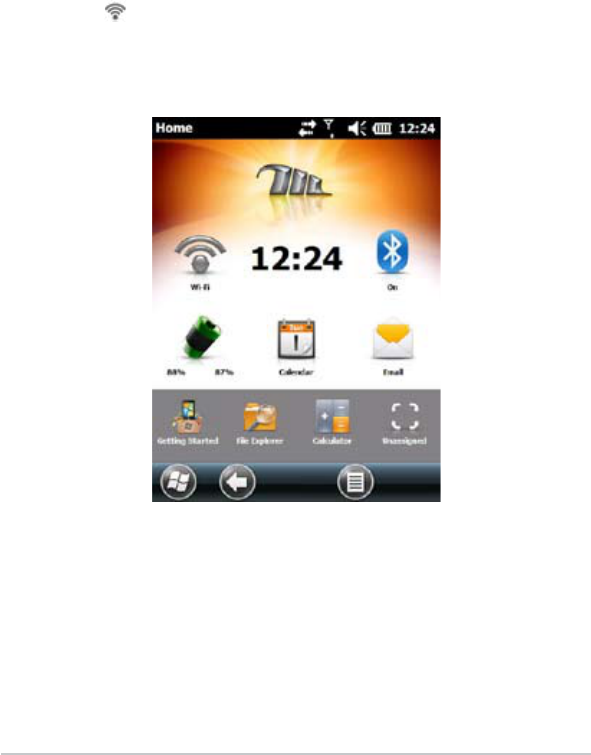
50 Mesa Rugged Notepad Owner’s Manual
Wi-Fi Wireless Communication
The Mesa has built-in Wi-Fi wireless communication to connect
to the Internet or a work network
Connecting to a Wi-Fi Network
To use Wi-Fi, you need to be in range of an access point to
make a connection. To actively look for a network connection
complete the following steps:
1. From the Home screen, turn Wi-Fi on by tapping the Wi-Fi
gadget . The Mesa automatically starts scanning the area
for available Wi-Fi networks. (If this gadget is not on the
Home screen, go to Geing Started and select Set up Wi-Fi or
go to Start > Seings > Connections > Wireless Manager.).
2. Tap-hold the Wi-Fi Icon to go to the Wi-Fi control panel.
When the Mesa completes the scan, a list of available
networks and their strengths appears on the Wireless screen.
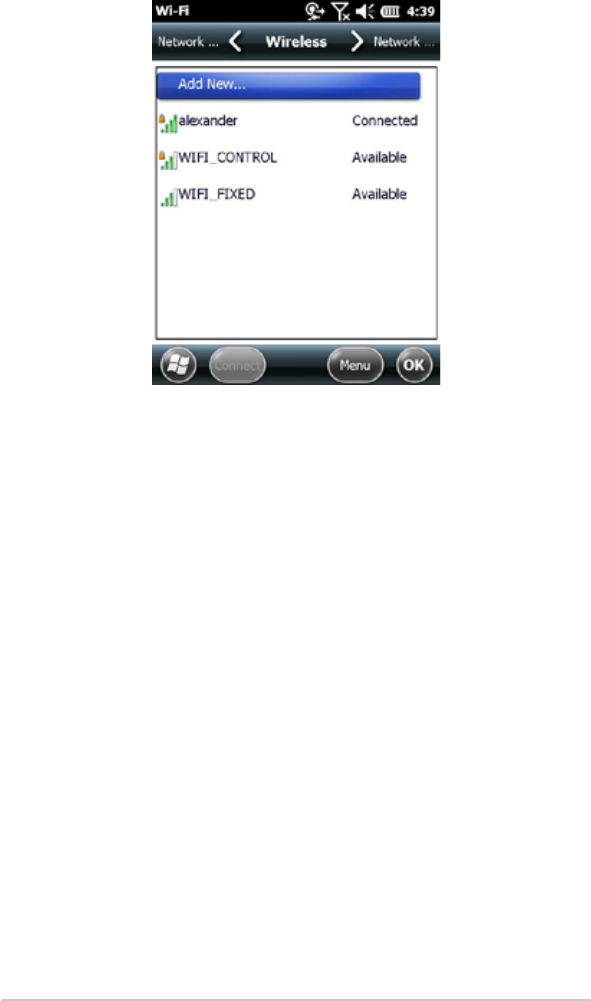
3. Tap on the network you want to connect to. If you want to
add a new network, select Add New from the top of the list.
4. Conguration and authentication set up screens are shown.
Depending on the network you are connecting to, you may
need to make some selections from pull down lists and
enter information like a passkey. Some information may
not be required or will appear automatically. When you are
nished with the set up screens, press Finish.
5. Select Network Adapters from the horizontal scrolling
conguration options. For connection options, select The
Internet or Work (for oce networks). Other seings can be
modied if necessary.
6. If you selected The Internet, you can open Internet Explorer
and begin using the internet.
Once a Wi-Fi network is set up, the icon on the Home Page
turns blue and the name of the network is shown.
The Mesa remembers the Wi-Fi network connections you
create.
Ch 5 Wi-Fi Wireless Communication 51
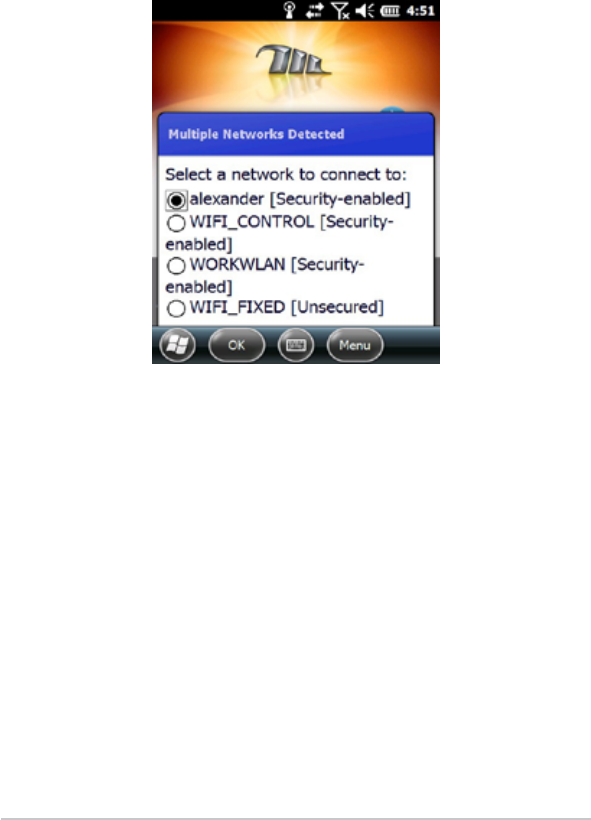
52 Mesa Rugged Notepad Owner’s Manual
Wi-Fi Dialog Box
Note: Whenever Wi-Fi is turned on, the following dialog box
might pop up indicating the Wi-Fi networks the Mesa has
located. You can select a new network and set it up without
going to the Wi-Fi control panel. Through the menu buon, you
can disable this dialog box from popping up in the future.
Adjusting Wi-Fi Settings
To add a new Wi-Fi network or edit seings, select the Menu
so key and make a selection from the pull-down list.
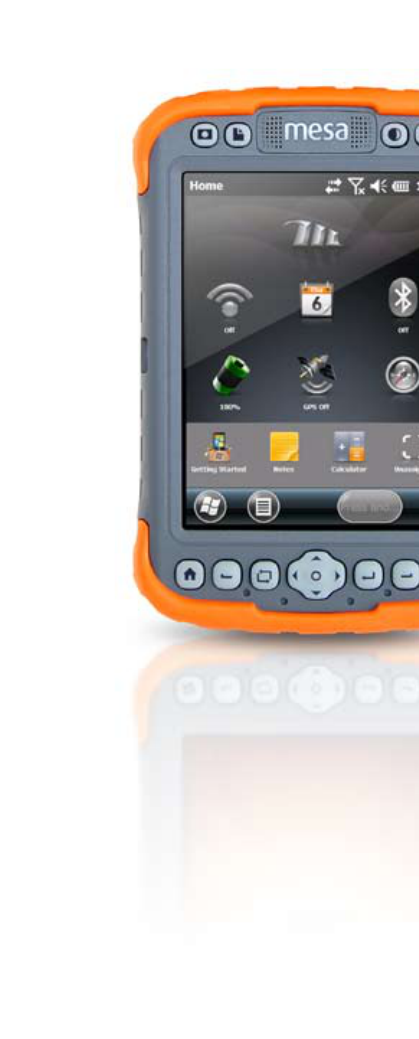
6
Geo Models
54 GPS
59 Camera
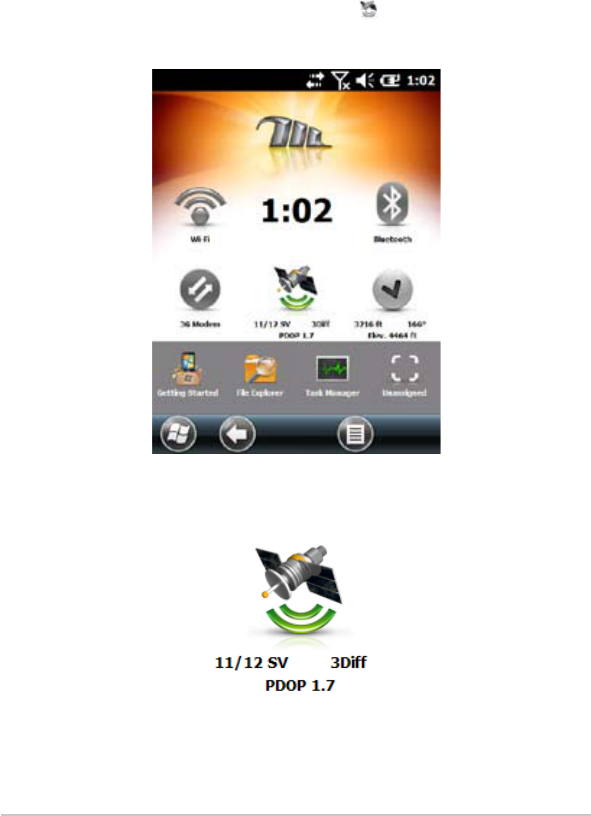
54 Mesa Rugged Notepad Owner’s Manual
Mesa Geo Model
The Mesa Geo model has GPS with 2 to 5 meter accuracy and a
3.2MP camera. Juniper Geotagging™ gives the Mesa the ability
to embed and emboss photos with the date, time and GPS
position. A 3G Data Modem is an optional feature.
GPS
To use GPS, tap on the satellite gadget to turn it on. The GPS
starts looking for satellites to use for a x.
Once enough satellites are found, the following information is
shown:
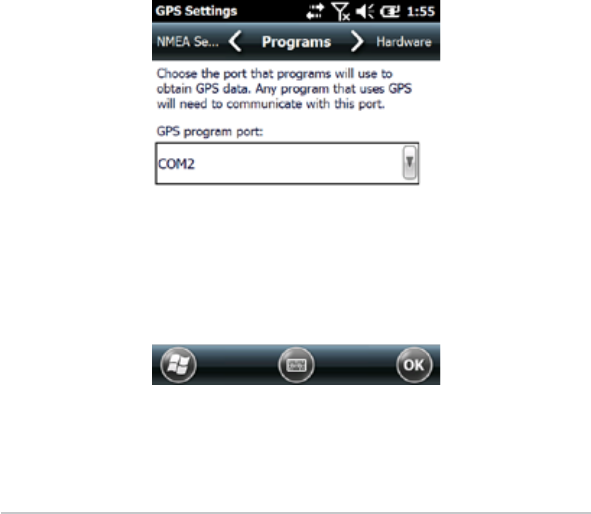
11/12 SV The number of satellites currently in view followed
by the number of satellites used for the current
position.
3Di The type of x you have. Three satellites are
required for a 2D x while 4 are required for a
3D x. 3Di means SBAS (WAAS/EGNOS/MSAS)
signal is being used for GPS solution.
PDOP A measure of accuracy. The lower the number, the
more accurate the x is.
Note: When you suspend the Mesa, the receiver is in a low power
mode to retain its almanac. When you resume the Mesa, it takes a few
seconds to get a x.
GPS Settings
Internal GPS uses COM7 at 38400 baud. To make changes to the
GPS seings or set up an external GPS, press and hold the GPS
gadget to go to the GPS Seings control panel.
Several applications can share the COM port set up as the GPS
program port using the GPS Intermediate Driver (GPSID).
Ch 6 Geo Models 55

56 Mesa Rugged Notepad Owner’s Manual
GPS Intermediate Driver
GPS Receiver Access for Multiple Programs
The GPS Intermediate Driver (GPSID) is used to allow more
than one program to use data from the GPS receiver. The GPS
Control Panel Seings page controls how the GPSID is used.
On Geo units, the internal GPS is on COM7 and communicates
at 38400 baud. These seings are found on the Hardware page
of the GPS Control Panel. If some other GPS receiver is to be
used, this is where you connect that GPS receiver so that the
GPSID can access it.
The GPSID can output the data on another COM port in a way
that allows multiple programs to access the same COM port.
This is called the Program Port and defaults to COM2 on Geo
models. This can be set up on the Programs page of the GPS
Control Panel.
The Camera as well as both the GPS Status and GPS Compass
gadgets use the GPSID to obtain the GPS information. Turning
o the GPSID (through the hardware port) will disable these
functions.
NOTE: If an application accesses the GPS module directly on COM7,
then the GPSID will not have access to the GPS. This will prevent
the Camera Geotag and GPS gadgets from functioning.
GPS Accuracy
The GPS antenna is in the extended antenna bumper. Don’t
put your hand or another object over the cap. This will reduce
accuracy. The more items between you and satellites, the lower
the accuracy will be.
GPS Compass
The compass is a navigation tool. You can set a waypoint and
navigate back to that location. To use the compass, turn GPS on
by tapping on the GPS gadget and wait until you have a x.
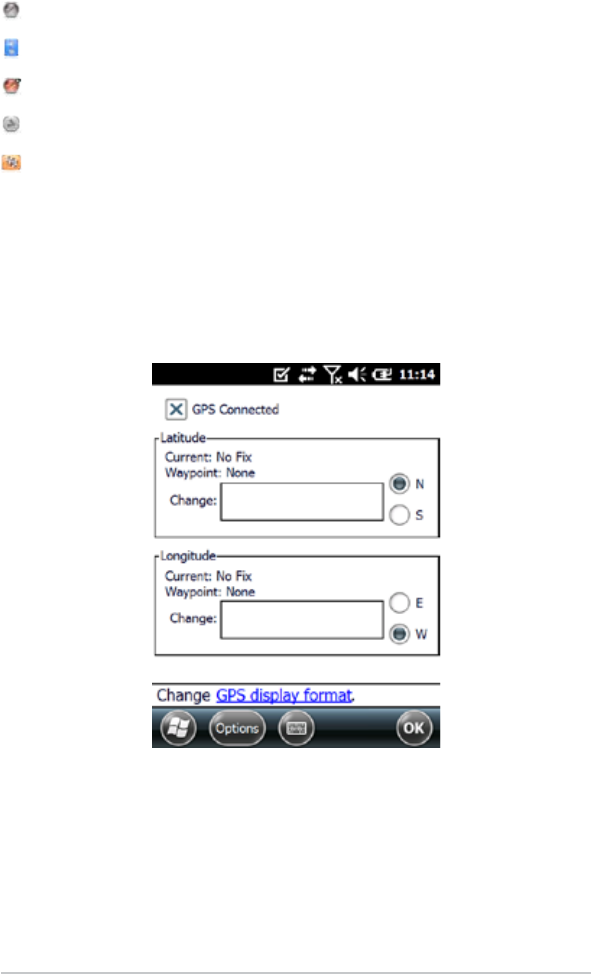
Compass Gadget Functions
Compass gadget is turned o.
Waypoint tool. Tap it to mark a waypoint.
No GPS x.
Arrow keys show your current heading or bearing.
This ag indicates that you are close to the waypoint.
Information about how many feet away you are, the elevation,
and degrees is also shown.
Navigation Settings
You can also enter a known waypoint. Tap and hold the
compass gadget to see the following dialogue box: Enter the
desired latitude and longitude.
Navigation Options
Select the Options sokey to set, clear, or mark a waypoint, set
up a breadcrumb trail, change the units of measurement, or turn
the power on or o.
Ch 6 Geo Models 57
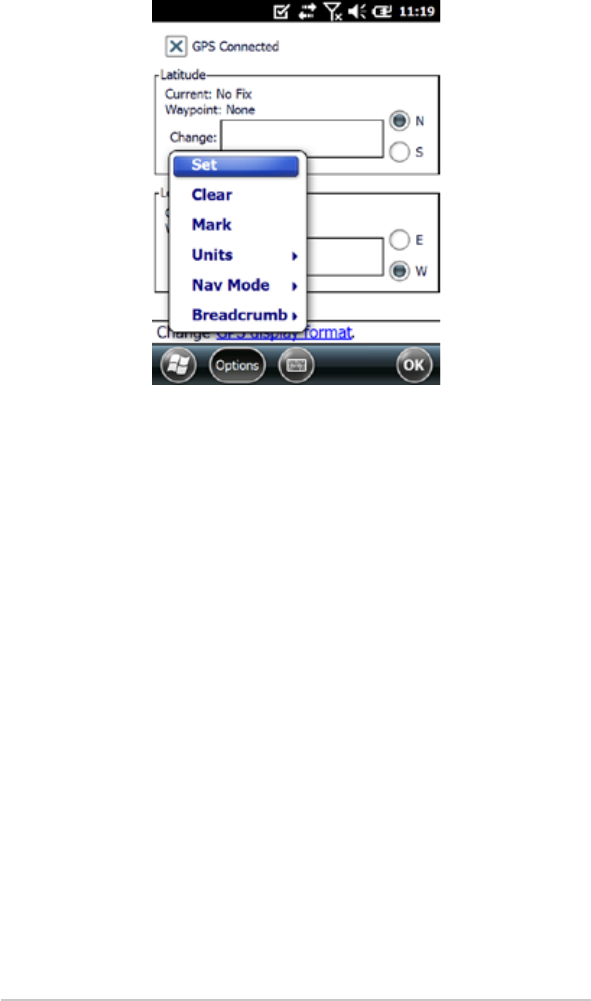
58 Mesa Rugged Notepad Owner’s Manual
Set: Take the coordinates in the “Change” boxes and set
these as the new waypoint.
Clear: Clear the waypoint (goes back to the blue ag).
Mark: Take the current GPS coordinate and set this as the
new waypoint.
Units: Displays units in either feet/miles for U.S. or meters/
km for metric.
Nav Mode:
Bearing – The arrow icon and angle displayed are
referenced o of North. Position the top of the device
toward North and the arrow will point in the direction to
travel to get to the waypoint. When in this mode an ‘N’ is
displayed before the angle.
Heading – The arrow icon and angle displayed show the
direction to travel to get to the waypoint relative to the
current direction of travel. This is a GPS Compass and
movement is needed to obtain direction information. If
movement is too slow, this data cannot be determined
and the stationary icon is displayed.
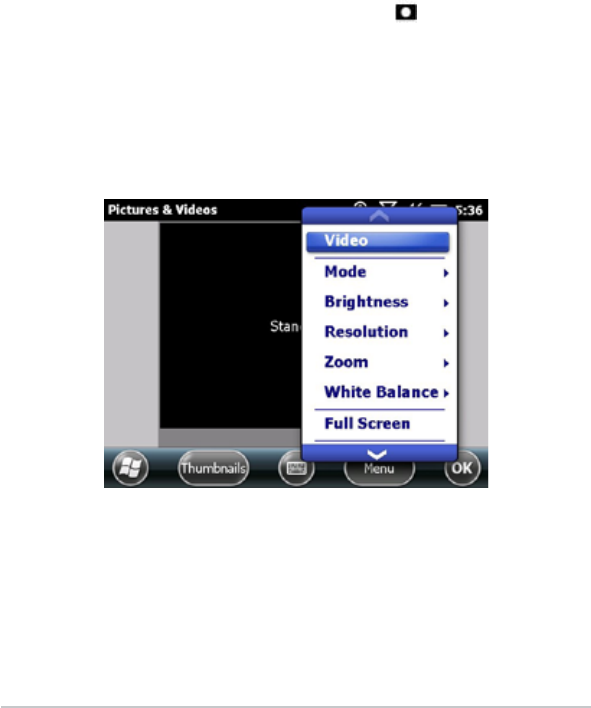
Breadcrumb: This is an independent function from
everything else in this gadget. Seing this logs points at
specic time intervals into the GPSTrack.gpx le.
There are three les created, 2 for waypoints and 1 for the
breadcrumbing. Waypoint information is saved in both the
GPSLoc.gpx and GPSLOC.csv. Both les contain the same
information, but in dierent formats. The breadcrumb data
is stored in the GPSTrack.gpx le. These les can be used in
programs like Google Earth.
Camera
To use the camera, press the camera buon . The camera turns
on and the Pictures and Videos application opens.
Note: The camera is always in landscape mode.
Select the Menu so key for a pull-down list of options. You
can change the default seings, including video or still photo,
brightness, resolution, type of le, autofocus option, etc.
Ch 6 Geo Models 59
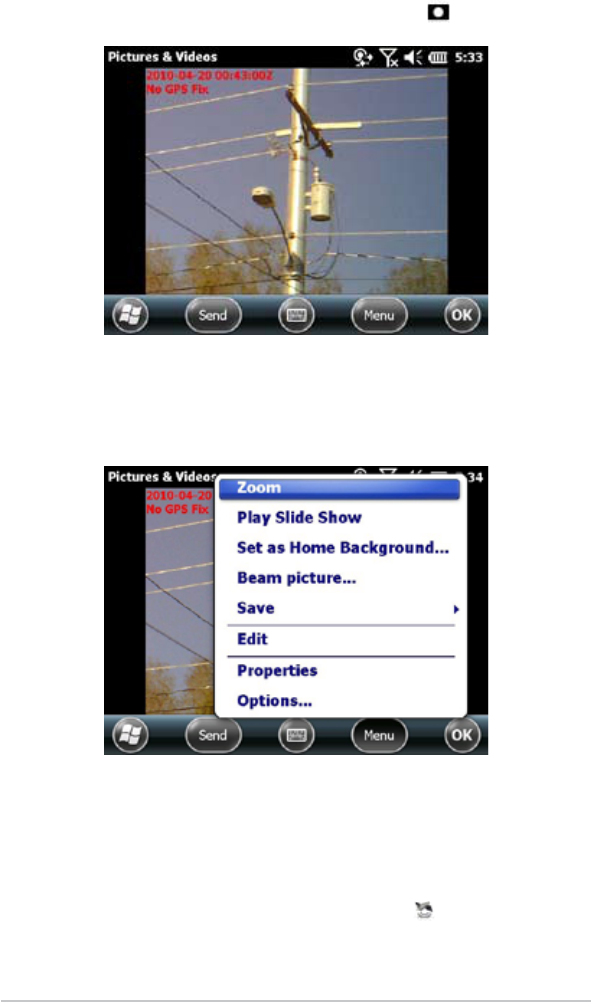
60 Mesa Rugged Notepad Owner’s Manual
Take a picture by pressing the camera buon .
To view your photo library select the Thumbnails sokey.
Select the Menu sokey to edit a particular picture, play a slide
show, etc.
Geotagging
When pictures are geotagged, the date, time, latitude, and
longitude are included with and/or on the image. To use this
feature, follow these steps:
1. Turn on GPS by tapping the GPS gadget on the Home
screen and wait for a x.
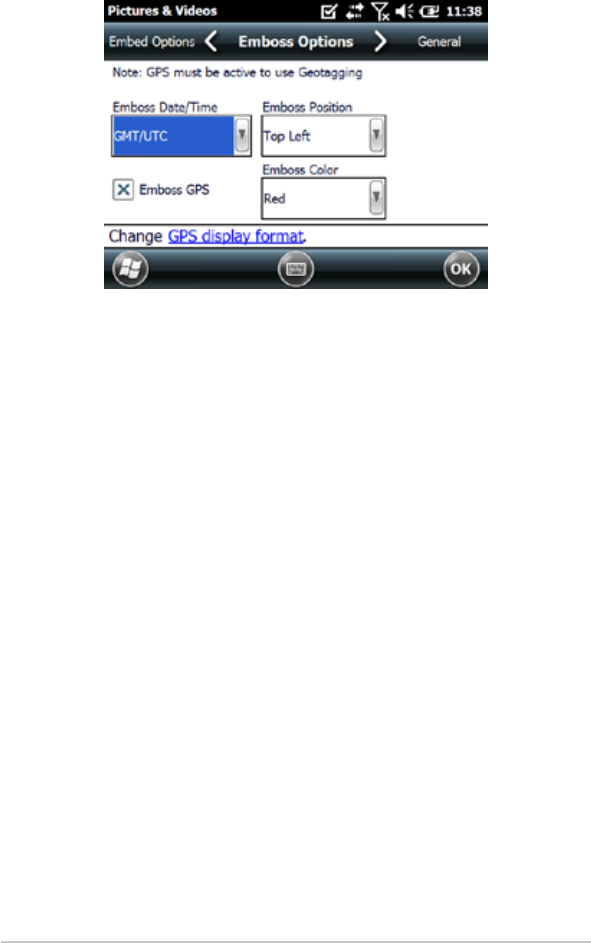
2. Select Geotag from the menu. The following Geotag
Options screen is shown:
Select the options you want.
Embed: select this option to build the GPS information into
a jpg le. This allows you to put the image into programs
like Google Earth, sort images by location, etc. The
information does not appear on the image.
Emboss: this option embosses the GPS information on the
picture making it part of the image. Select the embossing
location.
Videos
Select Video to from the Menu so key. Adjust seings as
desired. To take a video, press the camera buon to start
recording. Press it again to end the video. Sound is recorded
along with the video image.
Ch 6 Geo Models 61

62 Mesa Rugged Notepad Owner’s Manual
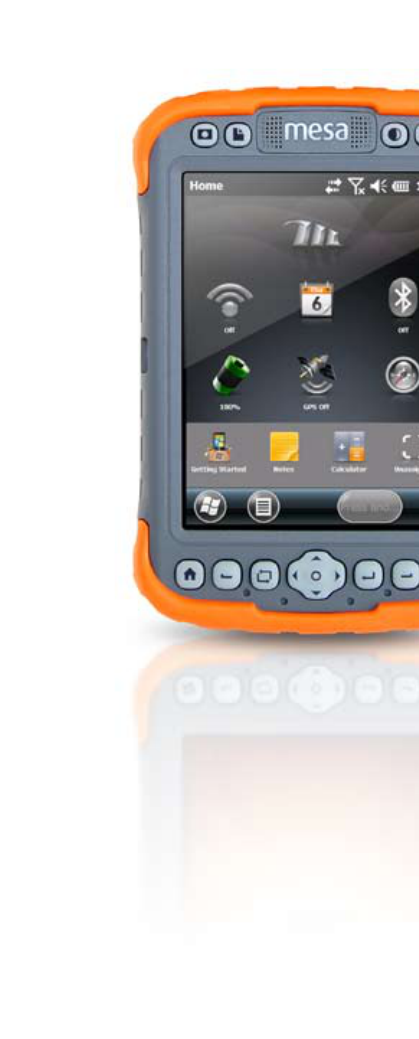
7
3G Data Modem
64 Set up an Account with a Wireless
Provider
64 Install the SIM Card
66 Set up the Cell Modem
67 Wireless Safety
68 Maintenance of Your Modem

64 Mesa Rugged Notepad Owner’s Manual
3G Data Modem
The 3G data modem is an option for Mesa Geo models, adding
Wide Area Network data modem capability to the Mesa. The
modem is installed at the factory.
The modem is a cellular data modem, type GSM/UMTS. It is
ve band modem compatible. The modem operates in dierent
modes depending on the wireless provider and the signal
strength. Data speeds will vary anywhere from 10 or 20 Kbps
when using GPRS to over 1 Mbps when using HSDPA.
Set up a Data Account with a Wireless Provider
Contact a wireless provider to set up data service for the
cellular data modem and obtain an account and SIM card. You
will need to provide the following information when seing up
an account:
1. Billing Information and business ID such as your Federal
Tax I.D. or VAT number.
2. The wireless services required. Specify that you need data
service only. You do not need voice or messaging service.
3. You may be asked for the modem’s IMEI number, which
can be found here: Start > Seings > System > System
Information > 3G Modem with the modem powered on.
4. You may be asked to provide the modem’s model number.
This number allows the carrier to verify this modem as one
of its approved models. If asked for this by the carrier, it is
a Juniper Systems Mesa.
Install the SIM Card
When you set up your wireless account, you are given a SIM
card. To insert or remove a card follow these steps:
1. Suspend or power o the Mesa if there is no baery in
compartment 2.
2. The SIM card slot is located in baery compartment 1.
Loosen the screws to the door and remove it.
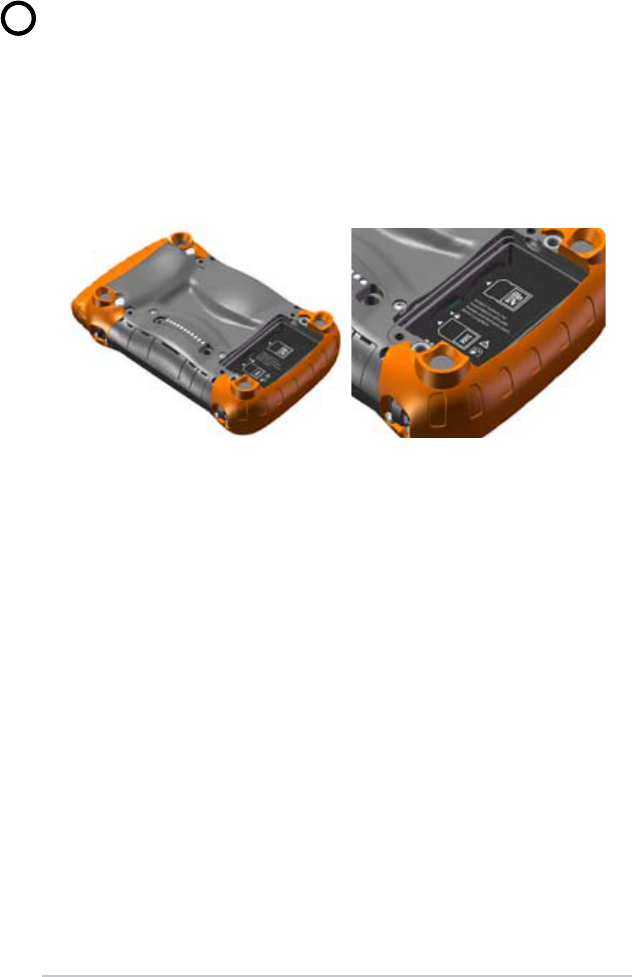
Ch 7 3G Data Modem 65
3. Remove the baery pack.
CAUTION: The Mesa is not totally sealed against water
and dust when baery doors are not installed and properly
latched.
4. An image on the baery compartment label shows the
correct location and orientation for the SIM card. Push the
card into the slot until it catches. To the right of the slot is a
latch to help hold the card in place. Slide it to the le over
the right end of the card towards the lock icon.
To remove the SIM card, slide the latch to the right. Press
and release the card to partially eject it. You may need
tweezers or needle-nose pliers to grab hold of the card to
remove it.
5. Replace the baery pack and aach the baery door.
6. Resume or power on the Mesa.
Note: If the modem was on before shuing the Mesa down to
insert the SIM card, you are prompted to congure the data
connection when you reboot. See the instructions on the following
pages.
!!
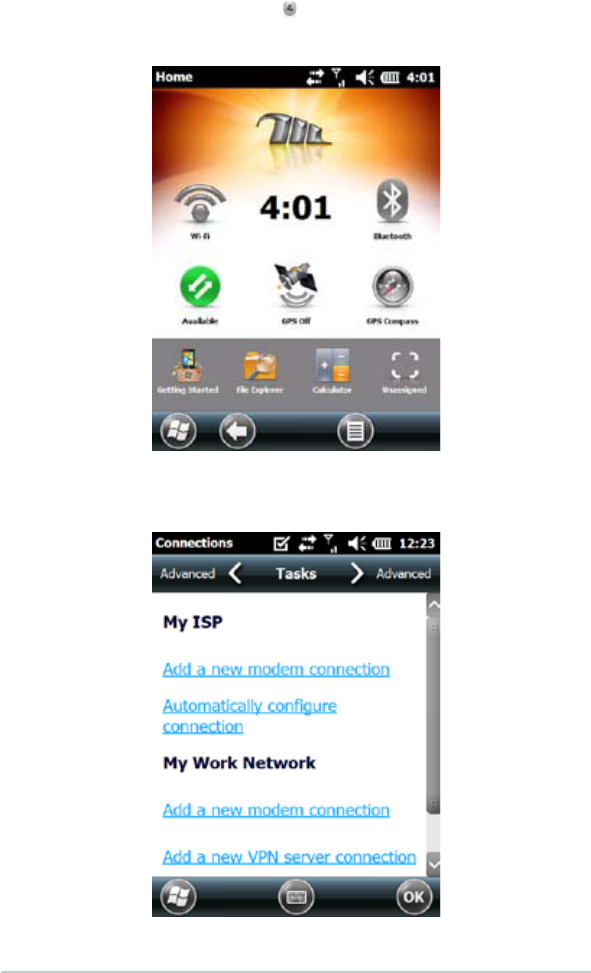
66 Mesa Rugged Notepad Owner’s Manual
Set up the Cell Modem
Tap on the 3G modem gadget . Aer about 30 seconds it
turns green, indicating that the modem is available.
Once it is available, congure it to make a connection. Tap and
hold the modem gadget to open the Connections control panel.

Ch 7 3G Data Modem 67
Select “Automatically congure connection.” The name of your
carrier appears. Tap Next. A progress is shown: on the next
screen while your internet seings are congured.
You can now access the internet. Open Internet Explorer to test
your setup.
Connection Problems
If the connection fails to automatically congure, there might
not be a signal where you are located. You can try repeating the
set up process.
Wireless Safety
RF Interference Issues
It is important to follow any special regulations regarding
the use of radio equipment due in particular to the possibility
of radio frequency, RF, interference. Please follow the safety
advice given below carefully.
Switch OFF your cell modem when in an aircra. The use of
cellular telephones in an aircra may endanger the operation
of the aircra, disrupt the cellular network and is illegal.
Switch OFF your cell modem in hospitals and any other
place where medical equipment may be in use.
Respect restrictions on the use of radio equipment in fuel
depots, chemical plants or where blasting operations are in
progress.
There may be a hazard associated with the operation of
your cell modem close to inadequately protected personal
medical devices such as hearing aids and pacemakers.
Consult the manufacturers of the medical device to
determine if it is adequately protected.
Operation of your cell modem close to other electronic
equipment may also cause interference if the equipment is
inadequately protected. Observe any warning signs and
manufacturers’ recommendations.

68 Mesa Rugged Notepad Owner’s Manual
Maintenance of Your Modem
Your cell modem is the product of advanced engineering,
design, and crasmanship and should be treated with care.
The suggestions below will help you to enjoy this product for
many years.
Do not aempt to disassemble the cell modem. There are no
user serviceable parts inside.
Do not place the cell modem alongside computer discs,
credit or travel cards, or other magnetic media. The modem
may aect the information contained on discs or cards.
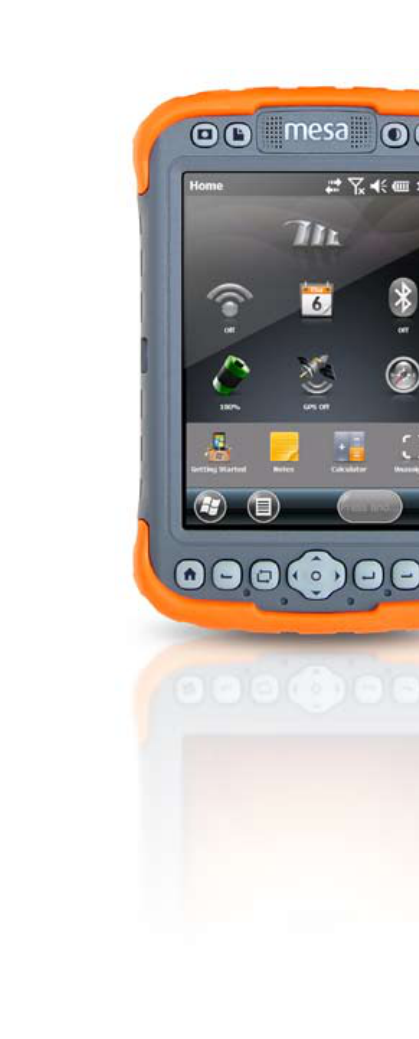
8
Storage,
Maintenance
and Recycling
70 Storing the Mesa and Battery
Packs
71 Protecting the Touchscreen
71 Cleaning the Mesa
72 Recycling the Mesa and Batteries

70 Mesa Rugged Notepad Owner’s Manual
Storage, Maintenance and Recycling
Follow the instructions in this chapter to properly maintain
and recycle the Mesa.
Storing the Mesa and Battery Pack(s)
When the Mesa is not being charged and is suspended, it draws
a small amount of power. This power draw is used to maintain
the memory (RAM) of the Mesa in the same state it was when it
was suspended. We recommend charging the Mesa each night or
weekend when it is in suspend mode.
If the Mesa is not charged while in suspend mode and the
baery reaches a low charge, it automatically powers o to
prevent further drain on the baery.
Data and programs are secure as long as they have been saved,
even if the baery pack becomes discharged. The Mesa does not
depend on the baery to store the data for extended periods.
Storing the Mesa for Less Than Two Weeks
To protect the les on your Mesa and the unit itself during
storage periods of less than two weeks, complete the following
steps:
1. Close all application programs.
2. Plug the Mesa into the AC wall adapter that was shipped
with your Field PC.
Storing the Mesa for More than Two Weeks
To protect the les on your Mesa and the unit itself during
storage periods of two weeks or more, complete the following
steps:
1. Charge the baery pack(s) 30% to 50%.
2. Close all running programs and turn o the Mesa.
3. Remove the baery pack(s).
4. Place the baery pack(s) in a dry location.

Protecting the Touchscreen
Protect the touchscreen from impact, pressure, or abrasive
substances that could damage it. To further protect the
touchscreen, apply one of the screen protectors that came with
the Mesa. To apply a screen protector, follow the directions that
come with it in the package.
CAUTION: Be sure to replace the screen protector as oen as
the screen protector instructions recommend.
Cleaning the Mesa
Touchscreen
1. Disable the touchscreen by pressing and holding the
touchscreen disable/enable buon or press the power
buon briey to suspend the device.
2. Remove the screen protector if you want to clean
underneath it.
3. Apply warm water or a mild cleaning solution to a
microber cloth and gently wipe o the touchscreen.
CAUTION: Do not use tissues, paper towels, so bristle
brushes, or harsh cleaning solutions on the touchscreen.
4. Rinse the touchscreen with water and dry it with a
microber cloth.
5. Apply a screen protector. (To clean a screen protector,
follow the instructions provided with the package.)
6. Enable the touchscreen by pressing the touchscreen
disable/enable buon or press the power buon to resume
the device.
Case, Bumpers and Communication Module
Make sure the baery doors are securely installed. Use warm
water, a mild cleaning solution, and a so bristle brush to clean
the case, bumpers and connector module.
!!
!!
Ch 8 Storage, Maintenance and Recycling 71

72 Mesa Rugged Notepad Owner’s Manual
CAUTION: Do not direct a high pressure stream of water at
the device to clean it. This action could break the seal, causing
water to get inside the device and voiding the warranty.
Safe Cleaners to Use
The Mesa can be cleaned safely with the following cleaners:
Windex® (S.C. Johnson & Son, Inc.)
Formula 409® (Clorox)
Citrus Wonder Cleaner (Mer-Maids)
Citrus All Purpose Cleaner (Wonder Tablitz)
Greased Lightening® Multi-Purpose Cleaner and Degreaser
Orange Clean® (Orange Glo International)
Fantastik® OxyPower® (S.C. Johnson @ Son, Inc.)
Oil Eater Orange Cleaner Citrus Degreaser (Kao
International, Ltd.)
CAUTION: Exposure to some cleaning solutions may damage
your device, including automotive brake cleaner, isopropyl
alcohol, carburetor cleaner and similar solutions. If you are
uncertain about the strength or eect of a cleaner, apply a small
amount to a less visible location as a test. If any visual change
becomes apparent, promptly rinse and wash with a known
mild cleaning solution.
Recycling the Mesa and Batteries
When the Mesa reaches the end of its life, it must not be
disposed of with municipal waste. It is your responsibility
to dispose of your waste equipment by handing it over to a
designated collection point for the recycling of waste electrical
and electronic equipment. If you cannot nd a location, contact
Juniper Systems for information about disposal.
The Li-Ion baery packs for your Field PC are recyclable. Avoid
placing them in the trash or municipal waste system.
!!
!!

To nd the nearest baery recycling center in the USA, visit the
Rechargeable Baery Recycling Corporation’s website at www.
rbrc.org/call2recycle/index.html or call 1-800-8-baery.
Ch 8 Storage, Maintenance and Recycling 73

74 Mesa Rugged Notepad Owner’s Manual
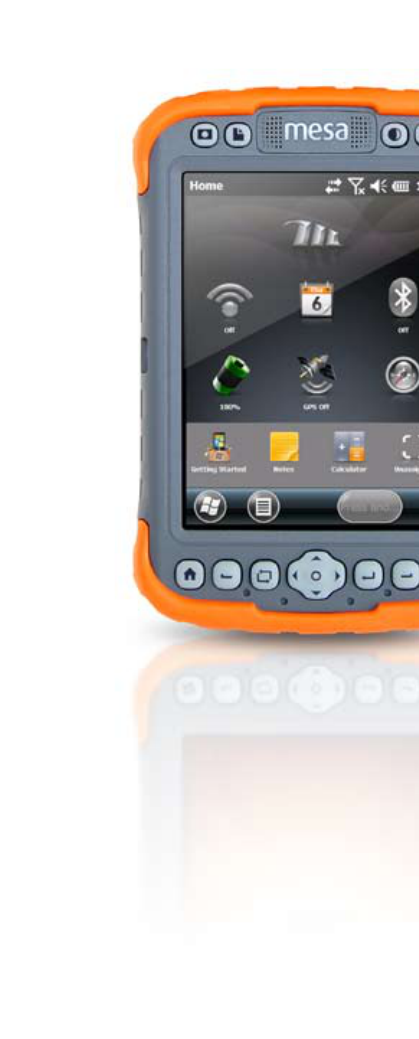
9
Warranty
and Repair
Information
76 Limited Product Warranty
78 Extended Warranties
79 Repairing the Mesa

76 Mesa Rugged Notepad Owner’s Manual
Limited Product Warranty
Juniper Systems, Inc. (“JS”) warrants that the Mesa Rugged
Notepad shall be free from defects in materials and
workmanship, under normal intended use, for a period of 12
months from the date of shipment.
JS warrants that the following items shall be free from defects
in materials and workmanship, under normal intended use, for
a period of ninety (90) days from the date of shipment:
baery packs,
media containing the Field PC programs,
desktop computer programs,
user documentation, and
accessories.
Warranty Exclusions
This warranty shall not apply if:
(i) the product has been set up improperly or has been
improperly installed or calibrated,
(ii) the product is operated in a manner that is not in
accordance with the user documentation,
(iii) the product is used for a purpose other than for which it
was designed,
(iv) the product has been used in environmental conditions
outside of those specied for the product,
(v) the product has been subject to any modication,
alteration, or change by or on behalf of customer (except
and unless modied, changed or altered by JS or under
direct supervision of JS),
(vi) the defect or malfunction results from misuse or accident,
(vii)
the serial number on the product has been tampered with
or removed, or
(viii)
the product has been opened or tampered with in any way.

This warranty is exclusive and JS will not assume and hereby
expressly disclaims any further warranties, whether express
or implied, including, without limitation, any warranty as
to merchantability, tness for a particular purpose, non-
infringement or any warranties arising from the course of
performance, dealing, or usage of trade. JS specically makes
no warranties as to the suitability of its products for any
particular application. JS makes no warranties that
its products will meet your requirements or will work in
combination with any hardware or applications soware
products provided by third parties,
the operation of its products will be uninterrupted or error
free, or
all defects in the product will be corrected.
JS shall not be responsible for soware, rmware, information,
or memory data contained in, stored on, or integrated with any
products returned to JS for repair, whether under warranty or not.
Remedy
In the event a defect in materials or workmanship is discovered
and reported to JS within the specied warranty period, JS will,
at its option, repair the defect or replace the defective part or
product. Replacement products may be new or reconditioned. JS
warrants any replaced or repaired product for a period of ninety
(90) days from the date of return shipment, or through the end of
the original warranty period, whichever is longer.
Limitation of Liability
To the fullest extent allowed by law, the obligation of JS shall
be limited to the repair or replacement of the product. JS shall
in no event be liable for special, incidental, or consequential,
indirect, special or punitive damages of any kind, or for loss of
revenue or prots, loss of business, loss of information or data,
or other nancial loss arising out of or in connection with the
sale, installation, maintenance, use, performance, failure, or
Ch 9 Warranty and Repair Information 77

78 Mesa Rugged Notepad Owner’s Manual
interruption of any product. Any responsibility and/or liability
of JS shall, in connection with a warranted product, be limited
in the maximum amount to the original purchase price.
Warranty Repairs
To obtain warranty repair or service on the Mesa, submit a
repair order on our website at www.junipersys.com > Support
> Repairs or contact an authorized repair center within the
applicable warranty period. Products returned for repair or
service without proper authorization may acquire an additional
handling fee and/or delay in the repair. The customer is
responsible to prepay all shipping costs when sending
equipment to a repair center. The repair center will return the
repaired equipment by the same method it was received with
costs of shipping prepaid.
Governing Law
This warranty is governed by the laws of Utah, and excludes
the United Nations Convention on Contracts for the
International Sale of Goods. The courts of Utah shall have
exclusive personal jurisdiction in case of any disputes arising
out of or in connection with this warranty.
Services and Materials Provided Under Warranty
Analysis of problem by service technician
Labor and materials required to x defective parts
Functional analysis performed aer repair
Repair turnaround within 10 working days of receipt unless
special circumstances exist
Shipping costs to return device to customer
Extended Warranties
The Mesa can be warranted up to 5 years (including the
standard warranty period) through the purchase of an
extended warranty.

Extended warranties apply only to the Mesa, not baery packs,
media containing the Mesa programs, desktop computer
programs, user documentation, and accessories. Parts that
are excessively worn are not covered under all warranty
plans. These may include, but are not limited to, the keyboard
elastomer and switch matrix, hand straps, touchscreens, and
connector modules.
Warranty Information
Warranty information for the Mesa Rugged Notepad is located
on our website at: www.junipersys.com > Support > Warranty.
You can evaluate and order warranty extensions, check
warranty status, and view warranty terms and conditions.
Repairing the Mesa
CAUTION: Do not aempt to repair the Mesa yourself. This
action voids the warranty.
Information about repairs, upgrades, and evaluations is
located on our website at: www.junipersys.com > Support >
Repairs. You can locate a repair center, submit a repair order,
check repair status, view terms and conditions, get shipping
instructions, and view lead times.
Before returning a unit, please get permission by submiing a
repair order from our website and waiting for conrmation or
by contacting a repair center directly. Be prepared to provide
the following information:
Product serial number (inside the baery compartment; also
found in System Information screen as described on the
following page)
Your name
Name and shipping address of company/university/agency
Best contact method(s) (phone, fax, email, cell (mobile))
Clear, highly-detailed description of the repair or upgrade
!
Ch 9 Warranty and Repair Information 79
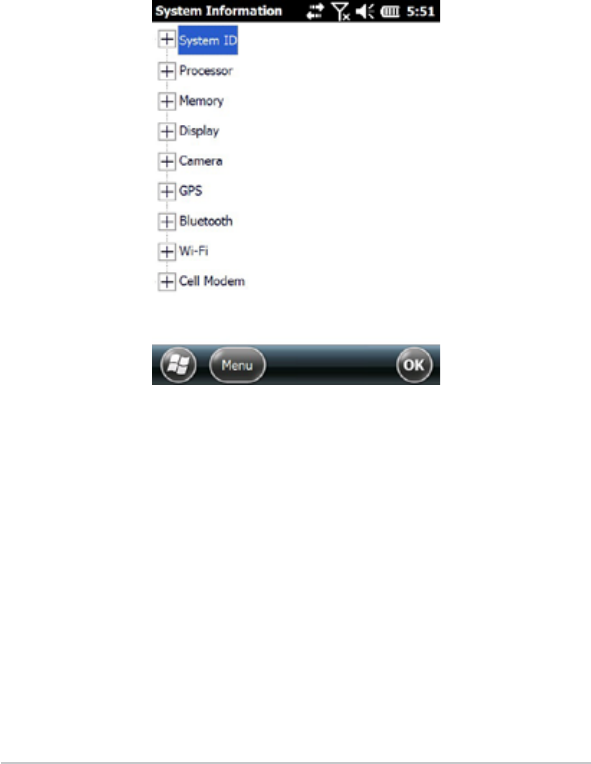
80 Mesa Rugged Notepad Owner’s Manual
Credit Card/ Purchase Order number and billing address
(for a repair or upgrade that is not covered by the standard
warranty or an extended warranty policy)
System Information for your Mesa
When you contact a repair center you need some unique
system ID information for your Mesa (serial number, model
number, etc.). Tap Start > Seings > System > System Information
to view the following menu. Select System ID.
Specications on the processor, memory, display, camera (Geo
models), GPS (Geo models), Bluetooth, Wi-Fi, and cell modem
(optional accessory) are also located on the System Information
Screen.
You can also create a system information le to send to the
repair center by pressing the Menu so key and selecting Create
Info File.
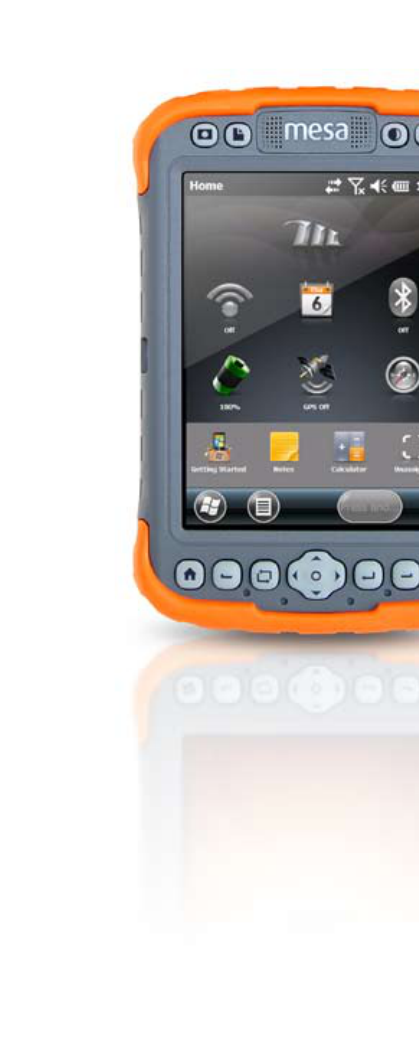
A
Specications
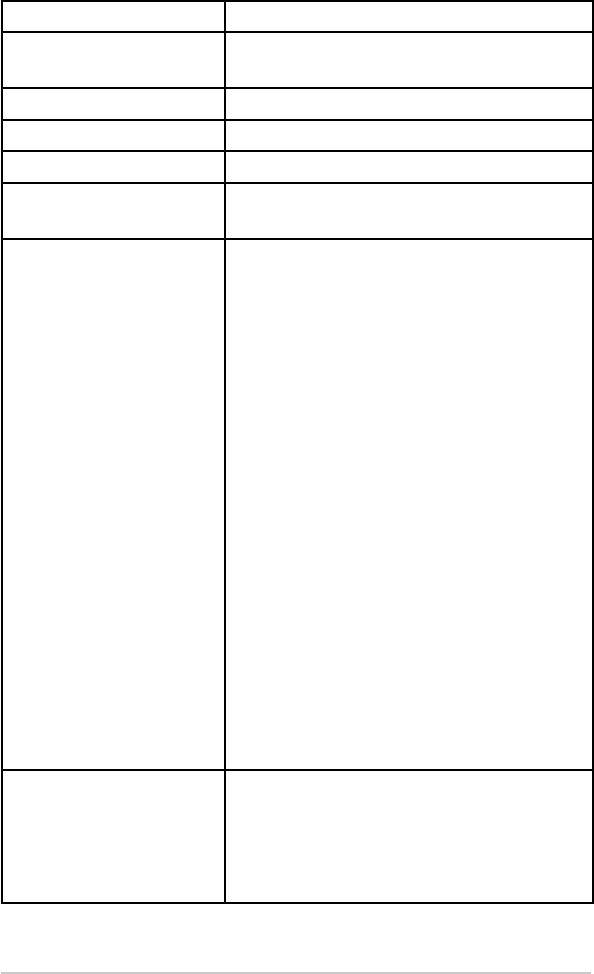
82 Mesa Rugged Notepad Owner’s Manual
Mesa Rugged Notepad Specications
FEATURE SPECIFICATION
Operating System Microso® Windows Mobile® 6.5
English, French, German, Spanish
Processor Marvell XScale 806 Mhz Processor
Memory 256 MB RAM
Primary Data Storage 4 GB Flash Storage
SD Card Slot SD/SDHC slot, full sized, user
accessible
Physical Features Dimensions, standard: 5.3” x 7.5” x
2” (136 mm x 200 mm x 51 mm)
Dimensions, Geo model: 5.3” x 8.6”
x 2” (136 mm x 220 mm x 51 mm)
Weight, Mesa standard with
one baery: 1.9 lbs (862 g), Mesa
Geo with two baeries: 2.34 lbs
(1061g), Mesa Geo 3G with two
baeriesand cell modem: 2.36 lbs
(1070 g)
Magnesium alloy case front, plastic
back
Impact absorbing elastomer
bumpers
Four mounting holes for external
accessories, #8-32 thread
rectangular paern, 3.45” x 4.11”
(87.63 mm x 104.39 mm), .3” deep
(7.62 mm)
Hand strap, adjustable, aach to
any side
Display 5.7” (145 mm) color VGA LCD
640 x 480 pixel resolution
LED backlight
Outdoor viewable
Portrait or landscape orientation

FEATURE SPECIFICATION
Touchscreen Resistive technology for use with
nger or stylus
Touchscreen disable function
Keyboard 15 control buons (6 reassignable)
Function keys
Five-way directional buon
Backlight
On-screen keyboard
Baeries Rechargeable Li-Ion baery pack
7.4VDC 2550mAh, 18.87Wh
2 baery pack compartments
Run time of 8 to 16 hours
Charging time 2 to 6 hours
Built-in baery intelligence
User-replaceable without tools
Connector I/O
Module
RS-232C 9-pin D-sub connector,
+5V @ 500 mA available on DTR
pin 4 (can also be congured
on ring in pin 9 via soware
conguration)
USB Host (Full A)
USB Client (Mini B)
12VDC jack for power input and
baery charging, +12V DC 1.5A
3.5mm audio jack, supports
speaker/microphone or stereo
output (pin detect).
Connector protector
Wireless Connectivity Bluetooth® wireless technology 2.0
+EDR Class 1,
Wi-Fi 802.11b/g, U.S. and
international
Appendix A Specications 83

84 Mesa Rugged Notepad Owner’s Manual
FEATURE SPECIFICATION
Audio Speaker, forward facing, loud,
clear
Microphone, low noise
3.5mm audio jack, supports stereo
headset and microphone at the
same time (speaker disable)
Activity Indicators Red: boot/startup status, power
applied/charging status
Green: suspend/resume status,
application programmable
Blue: application programmable
On screen boot/startup indication
Temperature
Specications
Operating Temperature: –4° to 122°
F (–20° to 50° C) Note: Bluetooth®
wireless technology is rated to -4
degrees F (-20 degrees C)
Storage Temperature: *–22° to 158°
F (–30° to 70° C)
Baery Charging Temperature: 32°
to 104° F (0° to 40° C)
Dust and Water
Sealing
IP67 rating, waterproof and
dustproof
Shock Resistance Withstands multiple 4’ (1.2 m)
drops onto concrete
Environmental MIL-STD810G standard for water,
humidity, sand and dust, vibration,
altitude, shock, low temperature,
high temperature, temperature
shock
Warranties 12 months for Mesa unit and
optional cell modem
90 days for accessories
Extended warranty options

FEATURE SPECIFICATION
Soware Included ActiveSync
Adobe Reader LE
Alarms
Calculator
Calendar
Contacts
E-Mail
File Explorer
Geing Started
Help
Internet Explorer
Internet Sharing
Juniper Home Screen,
customizable with selectable
dashboard gadgets and program
shortcuts
Marketplace
Messaging
Microso MyPhone
Microso® Oce Excel Mobile
Microso® Oce OneNote Mobile
Microso® Oce PowerPoint
Mobile
Microso® Oce Word Mobile
Notes
Pictures & Videos
Remote Desktop Mobile
Search
Seings
Task Manager
Tasks
Text Messaging
Windows Live
Windows Media
Appendix A Specications 85

86 Mesa Rugged Notepad Owner’s Manual
FEATURE SPECIFICATION
Congurations Standard U.S. (4GB storage, U.S.
Wi-Fi, Bluetooth)
Standard International (4GB
storage, International Wi-Fi,
Bluetooth)
Geo U.S. (4GB storage, U.S. Wi-Fi,
Bluetooth, Camera, GPS)
Geo International (4GB storage,
International Wi-Fi, Bluetooth,
Camera, GPS)
Geo 3G U.S. (4GB storage, U.S.
Wi-Fi, Bluetooth, Camera, GPS,
GSM Data Modem)
Geo 3G International (4GB storage,
International Wi-Fi, Bluetooth,
Camera, GPS, GSM Data Modem)
Camera (Geo models) 3MP resolution
Autofocus
JPEG image format
Juniper Geotagging; embed and/or
emboss photo with date, time and
GPS position
GPS (Geo models) 2 to 5 meter typical accuracy
GPS receiver is a uBlox NEO
Integrated real-time SBAS
capability, support for WAAS,
MSAS, EGNOS
File format NMEA-0183 v2.3,
default strings: GGA, GSA, GLL,
GSV, TXT, RMC, VTG
Track 12 or more satellites
simultaneously
Juniper Home Screen GPS signal
quality indicator
Juniper Home Screen GPS compass

FEATURE SPECIFICATION
3G Data Modem (Geo
model option)
Factory installed option
Five band GSM/GPRS/EDGE,
850/900/1800/1900/2100 MHz data
speeds
Does not support voice calls
Communicates on GSM-based
networks
Certications and
Standards
FCC Class B
CE Marking (applicable EMC,
R&TTE, and LVD directives)
Industry Canada
EN60950 Safety
Bluetooth SIG qualication
USB client
IP67
Designed to MIL-STD 810G
Standard Accessories Li-Ion baery(s)
Hand strap
Stylus
USB sync cable
Wall charger
Input: 100-240VAC, 50/60Hz, 0.5A
Output: 12VDC, 1.5A
Screen protectors: 1 Ultra-Clear, 1
Anti-Glare
Connector protector
Documentation CD
Optional Accessories Shoulder strap
Serial cable
Cigaree Lighter Charging
Adaptor
Travel charger (for 1 or 2 baeries)
Mesa Mobile Dock with desktop
base or vehicle mount
Appendix A Specications 87

88 Mesa Rugged Notepad Owner’s Manual
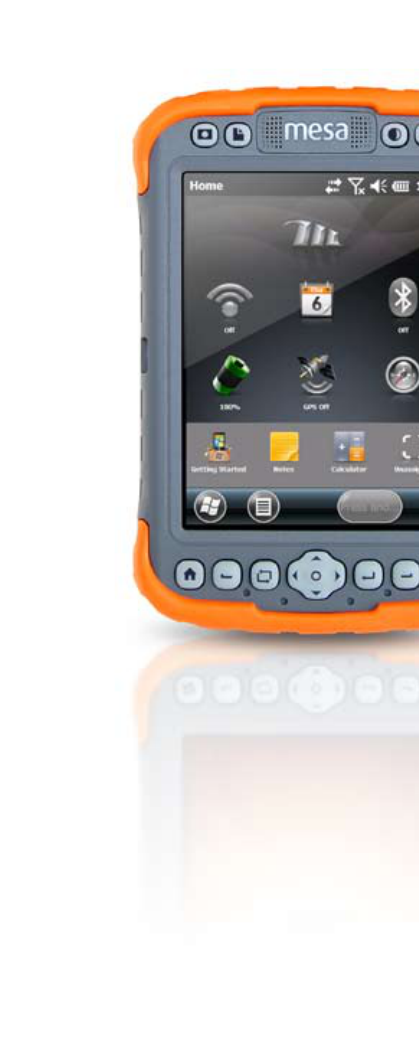
B
Warnings and
Regulatory
Information
90 Product Warnings
91 Mesa Certications and
Standards

90 Mesa Rugged Notepad Owner’s Manual
Product Warnings
Follow the warnings listed below to use the Mesa and
accessories safely.
Battery Warnings
WARNING! This device comes with a lithium ion rechargeable
baery pack. To reduce the risk of re or burns, do not
disassemble, crush, puncture, short external contacts, or expose
the baery pack to re.
Do not disassemble or open, crush, bend or deform, puncture
or shred.
Do not modify or remanufacture, aempt to insert foreign
objects into the baery, immerse or expose to water or other
liquids, expose to re, explosion or other hazard.
Only use the baery for the system for which it is specied
Only use the baery with a charging system that has been
qualied with the system per this standard. Use of an
unqualied baery or charger may present a risk of re,
explosion, leakage, or other hazard.
Do not short circuit a baery or allow metallic conductive
objects to contact baery terminals.
Replace the baery only with another baery that has been
qualied with the system.
Use of an unqualied baery may present a risk of re,
explosion, leakage or other hazard.
Promptly dispose of used baeries in accordance with local
regulations
Baery usage by children should be supervised.
Avoid dropping the baery. If the baery is dropped, especially
on a hard surface, and the user suspects damage, take it to a
service center for inspection.
!

Improper baery use may result in a re, explosion or other
hazard.
Wall Charger Warnings
WARNING! To reduce the risk of personal injury, electrical
shock, re or damage to the equipment:
Plug the wall charger into an electrical outlet that is easily
accessible at all times.
Do not place anything on the wall charger cord or any of the
other cables. Arrange them so that no one may accidentally
step on or trip over them.
Do not pull on a cord or cable. When unplugging the wall
charger from the electrical outlet, pull on the plug, not the cord.
Use only wall chargers intended for the Mesa. Using any other
external power source can damage your product and void your
warranty.
Mesa Certications and Standards
United States and Canada
In compliance with the FCC rules, 47 CFR 15.19(a)(3), and the
Industry Canada rules, the following statement must appear on
the device or in the user documentation.
This Class B digital apparatus complies with Canadian
ICES-003. This device also complies with Part 15 of the FCC
Rules. Operation of this equipment is subject to the following
two conditions:
1. The device may not cause harmful interference.
2. This device must accept any interference received,
including interference that may cause undesired operation.
!
Appendix B Product Warnings and Regulatory Information 91

92 Mesa Rugged Notepad Owner’s Manual
In compliance with the FCC rules, 47 CFR 15.105(b), the user
must be notied that this equipment has been tested and
found to comply with the limits for a Class B digital device,
pursuant to part 15 of the FCC Rules. These limits are designed
to provide reasonable protection against harmful interference
in a residential installation. This equipment generates, uses
and can radiate radio frequency energy and, if not installed
and used in accordance with the instructions, may cause
harmful interference to radio communications. However, there
is no guarantee that interference will not occur in a particular
installation. If this equipment does cause harmful interference
to radio or television reception, which can be determined by
turning the equipment o and on, the user is encouraged to
try to correct the interference by one or more of the following
measures:
Reorient or relocate the receiving antenna.
Increase the separation between the equipment and receiver.
Connect the equipment into an outlet on a circuit dierent
from that to which the receiver is connected.
Consult the dealer or an experienced radio/TV technician for
help.
In compliance with the FCC rules, 47 CFR 15.21, the user must
be notied that changes or modications to the Field PC that
are not expressly approved by the manufacturer could void the
user’s authority to operate the equipment.
Only approved accessories may be used with this equipment.
In general, all cables must be high quality, shielded, correctly
terminated, and normally restricted to two meters in length.
Wall chargers approved for this product employ special
provisions to avoid radio interference and should not be altered
or substituted.
This device must not be co-located or operating in conjunction
with any other antenna or transmier.

General Safety
CAUTION: This device has been evaluated for use in close
proximity to the body. Use only accessories approved by
Juniper Systems. The use of third party accessories may
not comply with FCC and international RF exposure
requirements. To comply with FCC and other national RF
exposure requirements do not co-locate this device with other
transmiers.
This device operates in compliance with the FCC radio
frequency exposure limits for an uncontrolled environment.
Users must follow instructions provided in the user
documentation to satisfy compliance with FCC radio frequency
exposure requirements.
There cannot be any alteration to the authorized antenna
system. The antenna shipped with the cell modem is the only
one authorized for use.
This cell modem is compliant with FCC regulations when
operated within the temperature range of -30°C to +50°C. Do
not operate the cell modem outside of this temperature range.
European Union (CE Marking)
Products bearing the CE marking comply with the
2004/108/EC (EMC Directive), 1999/5/EC (R&TTE
Directive), 2006/95/EC (Low Voltage Directive) issued by the
Commission of the European Community.
CE compliance of this device is valid only if powered with/by
a CE-marked wall charger provided by the manufacturer.
Compliance with these directives implies conformity to the
following standards:
EN 55022 (CISPR 22) Electromagnetic Interference
EN 55024 (IEC 61000-4-2, 3, 4, 5, 6, 8, 11) Electromagnetic
Immunity
EN 60950 (IEC 60950) Product Safety
!
Appendix B Product Warnings and Regulatory Information 93

94 Mesa Rugged Notepad Owner’s Manual
ETSI EN 300 328 Radio
ETSI EN 301 489-1, -7, -17 EMC for Radio Equipment
ETSI EN 301 511 GSM
ETSI EN 300 440 GPS
The telecommunication functions of this device may be used
in the following EU and EFTA countries: Austria, Belgium,
Bulgaria, Cyprus, Czech Republic, Denmark, Estonia,
Finland, France, Germany, Greece, Hungary, Iceland, Ireland,
Italy, Latvia, Liechtenstein, Lithuania, Luxembourg, Malta,
Netherlands, Norway, Poland, Portugal, Slovak Republic,
Romania, Slovenia, Spain, Sweden, Switzerland, and United
Kingdom.
Restrictions apply to the operation of the 802.11b/g radio in this
device. Use of channel 14 is outside of the band of frequencies
permied in the European Union and should not be used.
France (Radio Restrictions)
Restrictions apply to the operation of the Bluetooth radio in
this device. This equipment may be used indoors. Due to the
potential that this radio may transmit in excess of 10mW in the
band 2454 to 2483.5 MHz, outdoor operation is restricted.
Restrictions apply to the operation of the 802.11b/g radio in
this device. This equipment may be used indoors on channels
1 to 13. Outdoor operation is permied on channels 1 to 8, as
transmit power in the band 2454 to 2483.5 MHz is limited to
10 mW. The latest requirements may be found at: hp://www.
art-telecom.fr
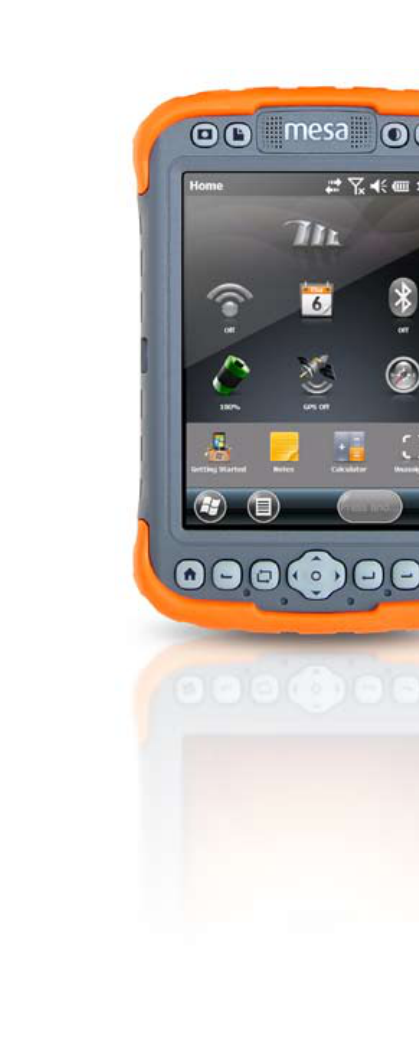
C
Charging
and Docking
Accessories
96 Mesa Mobile Dock
103 Mesa Travel Charger
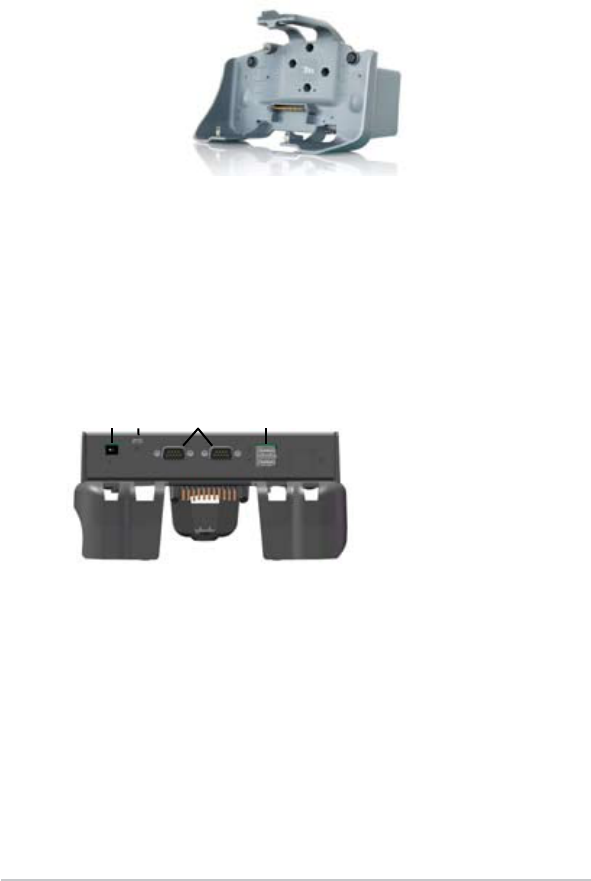
96 Mesa Rugged Notepad Owner’s Manual
Mesa Mobile Dock
The Mesa Mobile Dock is an optional accessory that provides a
mounting station for the Mesa Rugged Notepad and additional
communication options.
Note: The Mesa Mobile Dock is not functional as a stand alone device.
It requires the Mesa to be functional. For example, it is not a stand
alone powered USB hub.
Communication Options
The mobile dock provides additional communication ports for
use with sensors and other external devices, supplementing the
ports on the Mesa. Some Mesa ports are still accessible.
1. Power input jack, 12 VDC for power input and baery
charging: This jack is used to power the mobile dock
and the Mesa. The power port on the Mesa is not
accessible when it is in the mobile dock. The additional
communication ports on the dock are powered directly
from the Mesa or by applying power to the mobile dock.
The following accessories can be used to provide power
and charge the Mesa baeries:
1 12V DC power
input jack
2 USB client
3 RS-232 serial ports
4 USB host ports
123 4

a. AC wall power charger provided with the Mesa;
b. Cigaree lighter power adapter (optional accessory).
2. USB client: This is a through connection to the Mesa USB
client port. This port on the Mesa is not accessible when it
is in the mobile dock.
3. RS-232 serial ports: The mobile dock provides two
additional RS-232 ports. The RS-232 port on the Mesa is still
accessible when it is in the mobile dock, providing three
ports total.
Note: The dock serial ports do not have 5V power available on
their DTR or RI pins for powering devices.
4. USB host ports: The mobile dock provides two additional
USB host ports. The USB host port on the Mesa is still
accessible when it is in the mobile dock, providing three
ports total. Each port has 500mA available when external
power is plugged into the mobile dock. If external power
is not plugged into the dock and they are drawing power
from the Mesa, 100mA is available on each USB host ports.
In this scenario it is recommended that no more than
300mA total be drawn from the USB host ports.
5. The audio jack of the Mesa is accessible when the Mesa is in
the mobile dock.
Mounting Options
Accessories are available for using the mobile dock as a
desktop base, mounting it onto a vehicle, and mounting it onto
a pole. You can also aach it directly to a wall.
Mesa Dock Desktop Base Kit
The desktop kit (optional mobile dock accessory) allows the
mobile dock to be used on a desktop or other at, stationary
surface. The kit includes a desktop base and four screws.
Installing the desktop base:
1. At the back of the dock near the boom there are two screw
Appendix C Charging and Docking Accessories 97
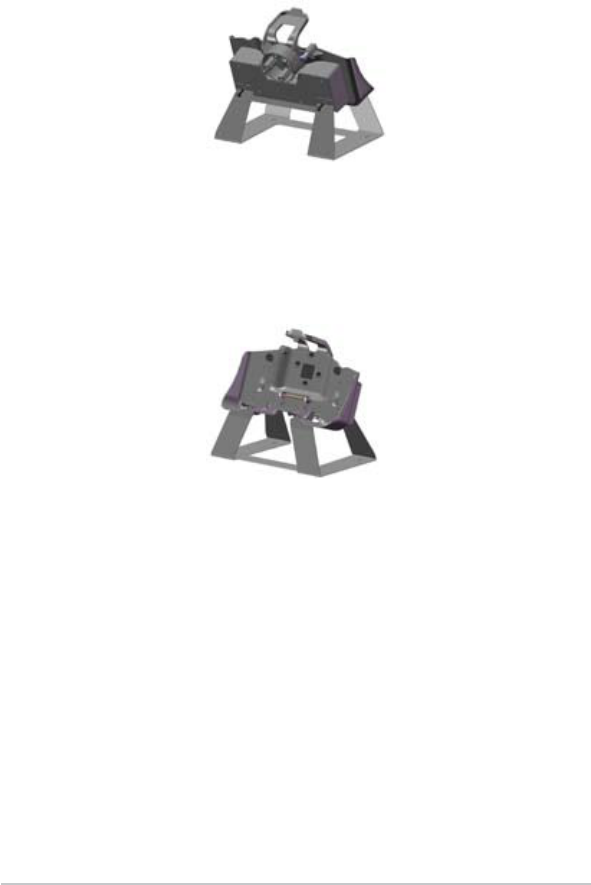
holes, one on the le and one on the right. Place screws into
these holes and screw them in half-way.
2. Slide the desktop base up so the screw slots on the back
slide onto the screws and tighten them.
3. In the front of the desktop base and on the dock near the
boom there are two screw holes, one on the le and one
on the right. Place screws into these holes, screw them in
all the way, and tighten them. The desktop base is now
ready to use.
Mobile Dock Vehicle Kit
The vehicle kit (optional mobile dock accessory) allows the
mobile dock to be used in a vehicle or in another mobile
mounting application. The kit includes two RAM mount bases,
a RAM mount arm, four screws, and four 8-32 nuts.
Note: Additional aachments are available for the vehicle kit from
National Products Inc. at www.ram-mount.com.
98 Mesa Rugged Notepad Owner’s Manual
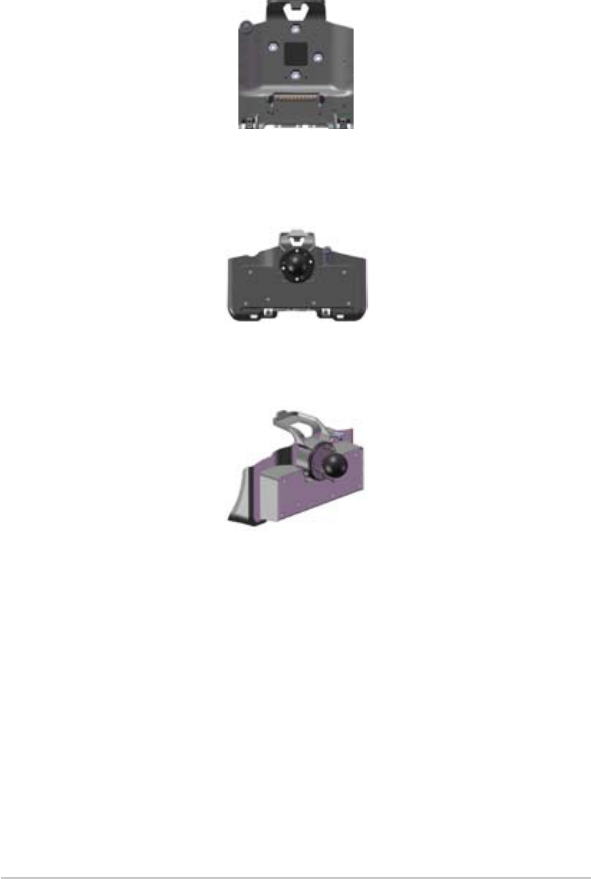
Installing the vehicle kit:
1. From the front of the dock you see four hex holes. Press a
nut into each hole. Use a screwdriver or similar object to
press them rmly into place.
2. From the back of the dock, align the ram mount with the
screw holes.
3. Insert the four screws into these holes, screw them in all
the way, and tighten them.
Appendix C Charging and Docking Accessories 99
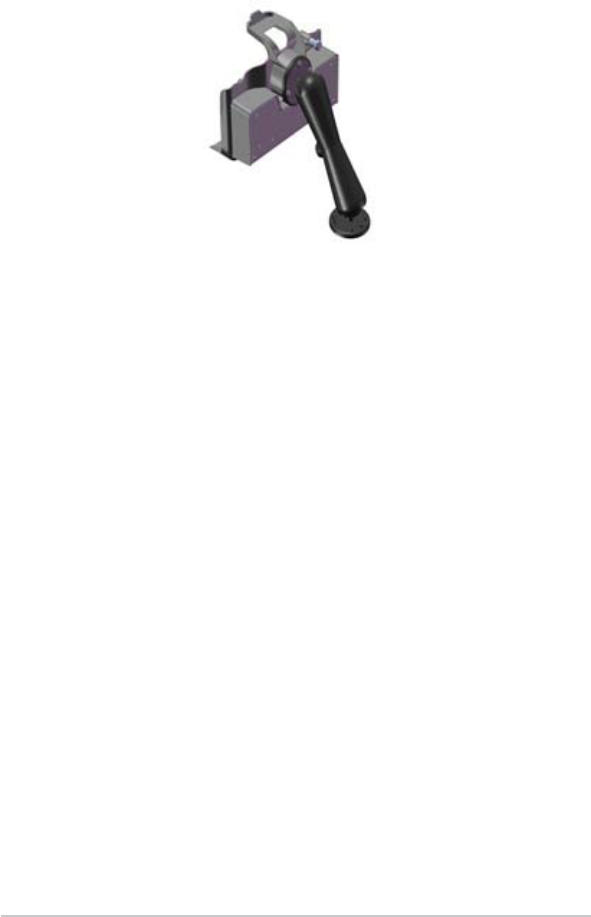
100 Mesa Rugged Notepad Owner’s Manual
4. Aach the arm to the two RAM mounts (one on each end).
The mobile dock is now ready to use in a vehicle, on a pole,
etc.
Vehicle power considerations:
When powering the dock from a vehicle, especially in a
permanent situation, be familiar with the power setup. Power
conguration options and recommendations:
The Mesa suspends when baery power is being used (default
seing), insuring that the both the Mesa baeries and the vehicle
baery are not fully depleted. In this conguration, the Mesa is
powered and charging its baeries whenever vehicle power
is applied. When the vehicle is turned o, the Mesa does not
receive external power and suspends aer the time set in
the power management seings (default is 3 minutes). In a
suspended state, the power to the mobile dock is shut o and
the Mesa draws very lile power (about 25mW).
The mobile dock is connected to a power port that draws current
directly from the baery power of the vehicle. The Mesa and dock
remain powered and the baeries are charged even if the
vehicle is turned o. Be aware that this conguration drains
the vehicle baery. Consult the vehicle’s user manual for
instructions on appropriate use of the power port.
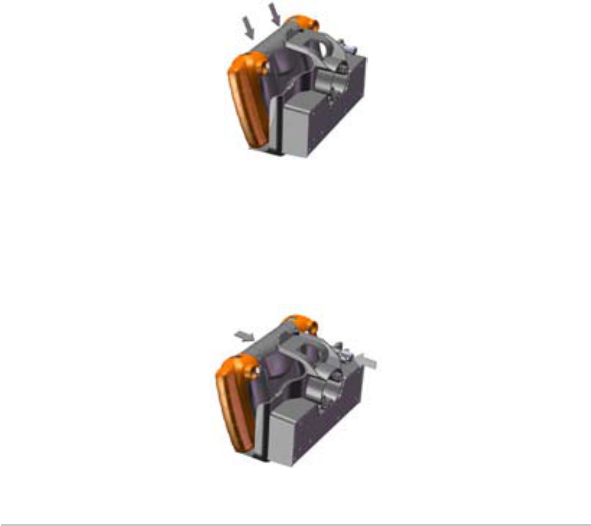
The mobile dock is connected to a key switched baery port of
the vehicle. The vehicle power is not depleted by the Mesa
when the vehicle is turned o. Be aware that with this
conguration the Mesa continues to power the dock ports,
depleting the Mesa baeries.
Wall Mount
You can mount the mobile dock to a wall. Use 2 size 8 wood
screws and aach the dock to a wall stud or plywood panel.
Attaching the Mesa to the Mobile Dock
Follow these instructions to place the Mesa into the mobile
dock:
1. Aach the connector protector to the Mesa and close the
individual port covers so the Mesa docks properly. If the
hand strap is in the way, remove or move it.
2. Align the Mesa with the lower mounting points on the
mobile dock.
2. Press the Mesa back to secure it to mobile dock. The top
latch snaps into place.
Note: Tighten the security bolt when the mobile dock is used in a
vehicle.
Appendix C Charging and Docking Accessories 101
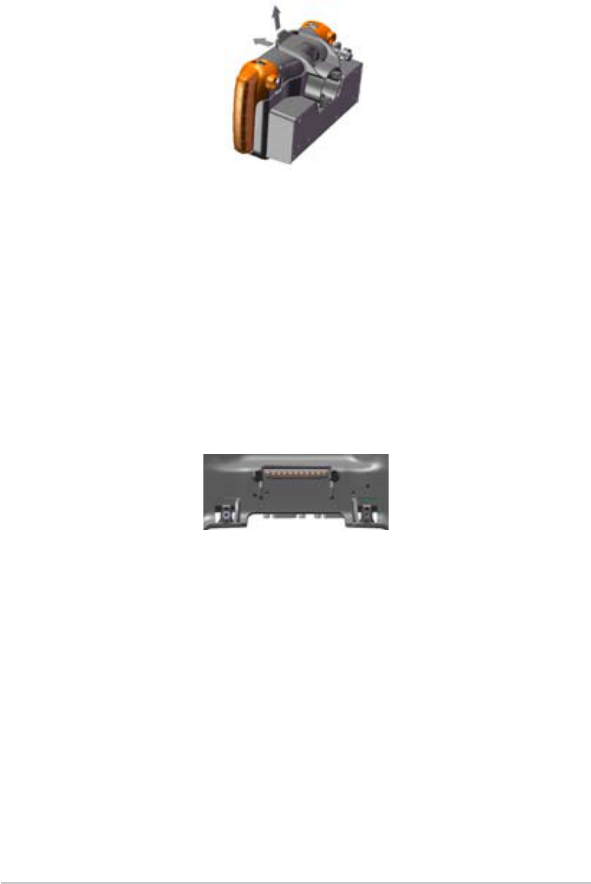
102 Mesa Rugged Notepad Owner’s Manual
Releasing the Mesa from the Mobile Dock
To release the Mesa from the mobile dock, li up on the top
latch. Pull the Mesa forward and remove it. Note: Loosen the
security bolt if the mobile dock is being used in a vehicle.
Maintenance
Environmental Issues
The mobile dock sheds water when used in its normal
conguration, but is not sealed against water. Avoid using the
dock in situations where water can enter the connector ports.
Protecting the Docking Pins
Do not touch the docking pins (spring loaded contacts) with
conductive items when power is plugged into the dock. Do not
drop items on the dock that can damage the pins.
Keep debris o of the docking pins and the connectors to
mantain the best performance.
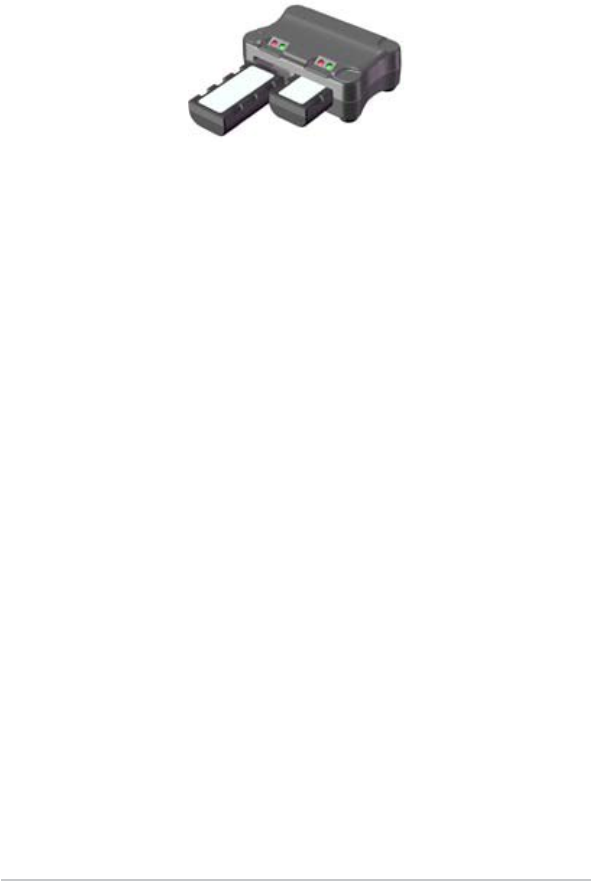
Mesa Travel Charger
The Mesa Travel Charger is an optional accessory that allows
you to charge Mesa baery packs on the go. One or two baery
packs can be charged at once.
How to Use the Travel Charger
1. Baery pack(s) should be charged at room temperature (68°
F or 20° C)
2. Place the travel charger on a at surface where it will be
undisturbed.
3. The following accessories can be used to provide power to
the travel charger:
a. AC wall power charger provided with the Mesa;
b. Cigaree lighter power adapter (optional accessory).
Plug a power adapter into the power input jack on the back
of the travel charger. Plug the other end into a wall outlet
or a vehicle cigaree lighter outlet.
4. Insert one or two baery packs into the charging slots.
Make sure you insert them fully. You will feel a slight
catch.
Charge Time
Two depleted baeries (in the charger at same time):
approximately 3.5 hours to fully charge.
One depleted baery: approximately 2.6 hours to fully charge.
LED Indicators
Each baery compartment has a green and red LED. The LED
states indicate the following:
Appendix C Charging and Docking Accessories 103

LED State Indicates
Red LED On Baery pack charging
Green LED
On
Baery pack fully charged
Red Flashing
LED
Baery pack or charging fault
Battery Pack or Charging Faults and Remedies
Possible causes for a ashing red LED:
Over-discharged baery: The baery pack is severely
depleted. The red LED ashes a few seconds aer the baery
is inserted. If the red LED continues to ash for a couple
of minutes, remove the baery pack. It might be faulty,
requiring replacement.
Pre-charge time out: A low baery pack is inserted and
the voltage does not reach an acceptable charge level. The
red LED ashes 30 minutes into the charge. The baery
pack might be at the end of its life or faulty, requiring
replacement. Note: Do not confuse this with the out-of-
temperature fault (next case).
Out-of-temperature range for safe charging: The charger
senses the baery pack is too cold (< 0˚ C, 32˚ F) or too hot
(> 40˚ C, 104˚ F) for safe charging. This can occur at any
time in the charge cycle. The red LED continues to ash,
even aer the baery pack is removed. Reset the charger by
inserting a baery pack with an acceptable temperature or
remove and reapply the external power to the charger. Bring
the temperature of the baery pack into the safe charging
range. If the problem persists, the baery pack might be
faulty, requiring replacement.
Charge cycle time out: The baery pack does not reach full
charge within eight hours. The baery pack might be at the
end of its life or faulty, requiring replacement.
104 Mesa Rugged Notepad Owner’s Manual
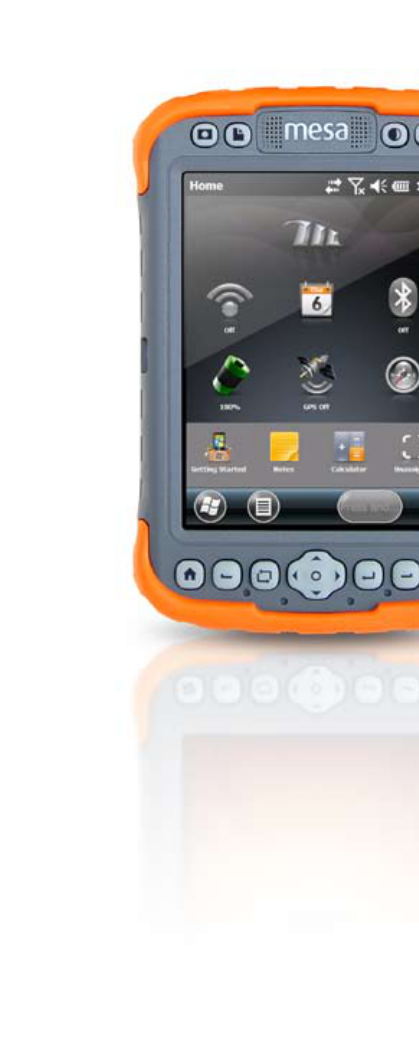
Index

106 Mesa Rugged Notepad Owner’s Manual
Index
Symbols
3G Data Modem 33, 64
Compliance and Regulatory Information 68
Connection Problems 66
Install SIM Card 33, 64
Maintenance of Your Modem 68
RF Interference Issues 63, 66
Set up Data Account with Wireless Provider 33, 64
Set up the Cell Modem 63, 66
A
ActiveSync
Creating a Connection 38
Anatomy of the Mesa 6
Audio Features 15, 28
Audio Jack 28
Microphone 15, 28
Speaker 15, 28
B
Backlight 19
Baery Pack 7, 10, 12, 14, 24, 25, 26, 27, 32, 65, 72, 85, 92, 106
Bluetooth Wireless Communication 42
Creating a Partnership 42
Microso Bluetooth Control Panel 41, 44
Serial Device (COM) Control Panel 46

C
Camera 7, 21, 53, 56, 59, 88
Videos 60, 88
Care and Maintenance
Cleaning 73
Storage 72
Less Than Two Months 72
More Than Two Months 72
Cautions 11, 24, 26, 36, 37, 65, 67, 73, 74, 81, 94
Cell Modem 63, 66
Certications and Standards 93
Cleaning the Mesa 71, 73, 74
Communicating With a Desktop Computer 29, 37
ActiveSync 38
Windows Mobile Device Center 38
Connector Module 8, 15, 27, 73
Connector Protector 27, 103
D
Dashboard Gadgets 32
Data Modem. See 3G Modem
Desktop Base 99
Desktop Computer, Communicating With 29, 37
Display 6
Backlight 18
Disabling 18
Display Seings 18
Orientation 18
Touchscreen 18
E
Equipment Warnings 93
F
Favorites Bar 32
Shortcuts 32
Features 6
Index 107

108 Mesa Rugged Notepad Owner’s Manual
G
Geo Model 54
Camera 7, 21, 53, 56, 59, 88
Geotagging 60, 88
Videos 60, 88
Geotagging 60, 88
Geing Started Screen 29, 38
GPS 6, 32, 33, 42, 46, 53, 54, 55, 56, 57, 58, 60, 61, 82, 88, 95. See
also Geo Model
Compass Gadget Functions 57
GPS Compass 32, 56, 58
GPS Intermediate Driver 55, 56
Navigation 57
GPS Compass 32, 56, 58
GPS Intermediate Driver 55, 56
H
Hand Strap 13
Home Screen 15, 17, 21, 29, 30, 87, 88
Dashboard 30, 31
Dashboard Gadgets 32
Status Icons 30, 31
Tile Bar 30, 34
Title Bar 30, 31
Touchable Tiles 30, 34
K
Keypad 15, 20
Function Buons 15, 20
Navigation Buons 15, 20
Press and Hold 15, 20
Press and Release 15, 20
Reassignable Buons 15, 20
L
LED Activity Indicators 15, 26
Limitation of Liability 79

M
Microphone 6, 27, 28, 86
Mobile Dock 7, 89, 97, 98, 99, 100, 102, 103, 104
Communication Options 98
Mobile Mounting 100
Mounting Options
Desktop Base 98
Vehicle Kit 98
Mounting Options 99
N
Navigating Around the Mesa
Touch Gestures 15, 16
Navigation, GPS 57
O
Online Help 29, 38
P
Power Input Jack 27, 98
Power Management
Baery Life 24
Baery Status 25, 32
Charging Baery Packs 24
Charging Errors 26
Power Seings 24
Power O 30, 34
Product Warnings 91, 92, 93, 95
R
Reassign Buon Functions. See also Keypad
Recycling the Mesa and Baeries 71, 74
Reset 30, 34
Restore 30, 34
Return Materials Authorization. See Repairing
RS-232C Port 8, 27, 85
Index 109

110 Mesa Rugged Notepad Owner’s Manual
S
Screen Protector 9
SD Cards 26
SDK 40
Speaker 6, 27, 28, 86
Specications 82, 83, 84, 85, 86, 87, 89
Storing the Mesa and Baery Pack 72
Suspend 30, 34
System Information 64, 81, 82
T
Temperatures
Charging Baery Pack. See also Baery Pack
Tile Bar 30, 34
Title Bar 30, 31
Touchable Tiles 30, 34
Touchscreen 6, 15, 18, 19, 21, 71, 73, 85
Protecting the Touchscreen 71, 73
Travel Charger 97, 105
U
USB Client 8, 27, 89, 98, 99
USB Host 27
V
Videos 60, 88

W
Warnings 92, 93
Warranty 78
Exclusions 78
Extended Warranties 80
Liability 77, 78, 79, 80, 81
Limited Product Warranty 77, 78, 79, 80, 81
Remedy 79
Repairs 80
Services 80
Warranty Exclusions 77, 78, 79, 80, 81
Warranty Repairs 80
Wi-Fi Wireless Communication 49, 50, 51
Connecting to a Wi-Fi Network 49, 50, 51, 54
Managing Connections 51
Status Icons 50
Wi-Fi Dialog Box 52
Wi-Fi Seings 52
Windows Mobile Device Center 38
Windows Start Menu 15, 17
Index 111

112 Mesa Rugged Notepad Owner’s Manual